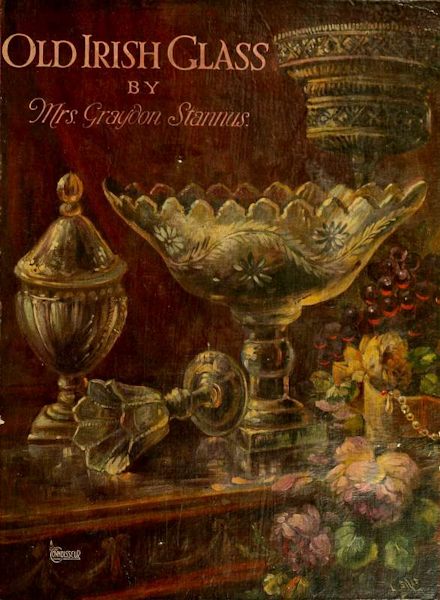
The Project Gutenberg EBook of Old Irish Glass, by Graydon Stannus This eBook is for the use of anyone anywhere at no cost and with almost no restrictions whatsoever. You may copy it, give it away or re-use it under the terms of the Project Gutenberg License included with this eBook or online at www.gutenberg.org Title: Old Irish Glass Author: Graydon Stannus Release Date: May 3, 2014 [EBook #45570] Language: English Character set encoding: UTF-8 *** START OF THIS PROJECT GUTENBERG EBOOK OLD IRISH GLASS *** Produced by Chris Curnow, Chris Jordan and the Online Distributed Proofreading Team at http://www.pgdp.net (This file was produced from images generously made available by The Internet Archive)

| THE CONNOISSEUR SERIES OF BOOKS FOR COLLECTORS |
OLD IRISH GLASS |
THE CONNOISSEUR SERIES OF BOOKS FOR COLLECTORS EDITED BY C. REGINALD GRUNDY |
OLD BY Mrs. GRAYDON STANNUS New Edition :: Revised and Enlarged 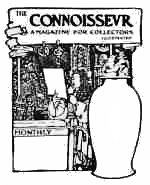
|
PUBLISHED BY THE CONNOISSEUR, 1, DUKE STREET, ST. JAMES'S, LONDON, S.W.1 MCMXXI |
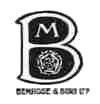
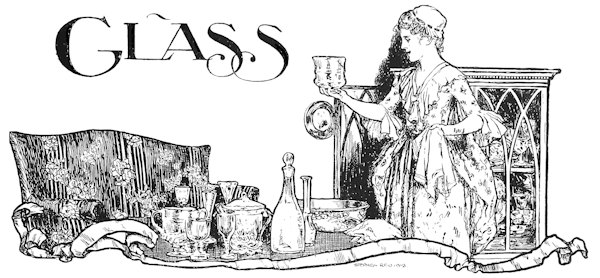 | |
|---|---|
| CONTENTS | |
| PAGE | |
| THE FASCINATION OF IRISH GLASS | 1 |
| GLASS FACTORIES IN IRELAND | 3 |
| Irish Gilding | 4 |
| The Last Maker | 4 |
| Glass-makers' Wages | 4 |
| Glass Cutters | 5 |
| WALL AND TABLE LIGHTS | 7 |
| CHANDELIER DROPS, PENDANTS, AND ORNAMENTS | 7 |
| THE CHARACTERISTICS OF IRISH GLASS | 10 |
| Weight | 10 |
| Colour | 10 |
| Resilience | 11 |
| The Feel of Irish Glass | 12 |
| The Ring of Irish Glass | 12 |
| Difference in the Ring of other Glass | 12 |
| FAKES | 12 |
| Difference of Colour | 13 |
| THE INCREASING POPULARITY OF IRISH GLASS | 13 |
| EXPERIENCE ESSENTIAL | 14 |
| IRISH GLASS SOLD ABROAD | 14 |
| UNCUT PIECES | 14 |
| THE ILLUSTRATIONS | 14 |
| LIST OF PLATES | |
| PLATE | |
| Card of Membership of the Cork Glass-cutters' Union | I. |
| Interior of a Primitive Hand Glass-cutter's Shed | II. |
| Device for Stoppering Bottles and Opening Pans | III. |
| Four pairs of Dublin and Waterford Wall-lights | IV., V., VI., VII. |
| Waterford Bowls. (Mr. Walter Harding) | VIII. |
| Waterford Bowl, circa 1783. Pontil worked into an ornament. (Commander Swithinbank) | IX. |
| Waterford Flower Bowl, circa 1783. (Commander Swithinbank) | IX. |
| Waterford Canoe-shaped Bowl, 1783. (Viscount Furness) | IX. |
| Cork "Turnover" Bowl, 12 in. high. (Mrs. Rea) | IX. |
| Christening Bowl, 1760. (Author) | X. |
| Munster Bowl, circa 1780. (Mrs. Hall) | X. |
| Irish "Pinched"-sided Bowl. (Mr. Henderson) | X. |
| Waterford Orange Bowl, circa 1790, 16 in. by 7½ in. (Major Pope) | X. |
| Irish Moulded Bowl, very large, 1760. (Mrs. Rea) | XI. |
| Irish "Pinched" Bowl, early, retaining waste metal at foot. (Author) | XI. |
| Irish "Pinched" Bowl, traveller's sample, 3 in. (Author) | XI. |
| Waterford Revolving Centre Dish, circa 1783. (Hon. Mrs. York) | XI. |
| Cork Glass Orange Bowl, circa 1790. (Mr. Walter Harding) | XII. |
| Waterford Bowl, circa 1790. (Viscount Furness) | XII. |
| Cork "Pillar" Bowl, early. (Viscount Furness) | XIII. |
| Irish Large Bowl of exceptional shape, circa 1785. (Author's family) | XIII. |
| Irish Glass, curious specimen of early, on carved bog-oak stand. (Commander Swithinbank) | XIV. |
| Irish Posset Bowl, large two-handled, possibly 1750. (Mrs. Hall) | XV. |
| Irish Ogee Bowl, circa 1760. (Mr. R. Frank) | XV. |
| Waterford Bowl, bearing the Stannus crest, 1790. (Author) | XVI. |
| Waterford Bowl and Basin, circa 1783. (Mr. Wild) | XVI. |
| Dublin copy of Bristol Two-handled Cup and Cover, circa 1780. (Mrs. Day) | XVI. |
| Waterford Giant "Turnover" Round Bowl and Dish, circa 1815. (Mrs. Rea) | XVI. |
| Waterford deep "Step"-cut Dish, circa 1825. (Mrs. Oliver) | XVI. |
| Waterford "Step"-cut Dishes with fan handles, circa 1820. (Mrs. Hall) | XVII. |
| Munster Banqueting Tazze, 1790-1810. (Mrs. Hall) | XVII. |
| Irish Posset Bowl, early, probably 1730. (Mrs. Rea) | XVIII. |
| Irish Urn, large, circa 1795. (Mr. R. Philipson) | XVIII. |
| Waterford "Canoe"-shaped Bowl, 1790. (Author's family) | XVIII. |
| Waterford Salad Bowl, circa 1785. (Col. Fitzgerald Stannus) | XIX. |
| Dublin Urns, very early. (Mr. Hugh Weguelin) | XIX. |
| Dublin Finger-bowl, early (marked). (Mr. R. Frank) | XIX. |
| Cork Bowl, circa 1785. (Mr. Henderson) | XX. |
| Irish Glass, three rare specimens of early, probably Dublin. (Mr. R. Philipson) | XX. |
| Irish Plain Punch-bowl and Ladle, circa 1770. (Mr. R. Frank) | XXI. |
| Waterford "Step"-cutting, examples of, after 1815. (Author) | XXI. |
| Waterford Bowl, one of the rarest extant, circa 1785. (Mr. Walter Harding) | XXII. |
| Waterford "Helmet" Bowl. (Major Courtauld) | XXII. |
| Waterford Dishes, pair of finely cut. (Major Courtauld) | XXII. |
| Waterford Chandelier, 1785. (Author's family) | XXIII. |
| Waterford Chandelier, 1788. (Author's family) | XXIV. |
| Waterford Chandelier. (Author) | XXV. |
| Waterford Sideboard Lights, Adam design, pair. (Author) | XXVI. |
| Waterford Chimney Set, with drops, probably Dublin, circa 1815. (Author) | XXVI. |
| Waterford Table Lights, set of three. (Viscount Furness) | XXVII. |
| Waterford Table Lights, set of four, circa 1785. (Viscount Furness) | XXVII. |
| Waterford Lights, on "Bosi"-work pedestals, pair. (Viscount Furness) | XXVIII. |
| Irish Table Lights, circa 1780, pair. (Author) | XXIX. |
| Waterford Table Lights, late Adam, on Wedgwood urns, pair. (Mr. Hugh Weguelin) | XXIX. |
| Waterford Table Lights, circa 1783. (Mr. E. Parsons) | XXX. |
| Waterford Table Lights, Adam period. (Major Pope) | XXX. |
| Waterford Candlesticks, 1785, pair. (Mr. H. Samuelson) | XXX. |
| Waterford Chandelier, 1783. (Mrs. Cox) | XXXI. |
| Waterford Candelabra and pair of Candlesticks. (Col. Jenner) | XXXI. |
| Waterford Chandelier, Adam. (Mrs. Sabin) | XXXII. |
| Irish Candle-shades, finest period, pair. (Author) | XXXIII. |
| Waterford Altar Candlesticks, circa 1783, pair. (Mr. R. Frank) | XXXIV. |
| Irish Candlesticks, probably 1760, three unique. (Mrs. Rea) | XXXIV. |
| Irish Candlesticks, with unusual bases, circa 1770, pair. (Mrs. Rea) | XXXV. |
| Waterford Tapersticks, circa 1790, pair. (Mrs. Rea) | XXXV. |
| Waterford (?) Lamps, 1790, very unusual pair. (Mr. Walter Harding) | XXXVI. |
| Waterford Candlestick, 1783. (Mr. Walter Harding) | XXXVI. |
| Cork Candlesticks, early, pair. (Mr. Walter Harding) | XXXVI. |
| Irish Rushlight Holders, blown-glass, early eighteenth century. (Mr. R. Frank) | XXXVII. |
| Waterford Table Lights, pair. (Mr. Fitzroy Chapman) | XXXVII. |
| Waterford Altar Candlesticks, pair, finest period. (Mr. Walter Harding) | XXXVIII. |
| Waterford Candlesticks. (Mr. Walter Harding) | XXXIX. |
| Dublin (?) Mug, circa 1740. (Mr. Walter Harding) | XXXIX. |
| Waterford Jug, shaped. (Mr. Walter Harding) | XL. |
| Irish "Freak" Jug, circa 1760. (Author) | XL. |
| Waterford Jugs, three. (Mr. R. Philipson) | XL. |
| Waterford or Cork Tankard, circa 1785. (Author) | XL. |
| Dublin (?) Two-handled Spun Cup, 1750. (Author) | XL. |
| Irish Jug, heavy lustre cut, flint glass, circa 1800. (Commander Swithinbank) | XL. |
| Cork Decanters, early blown, marked "Cork Glass Co.," pair. (Author) | XLI. |
| Munster Liqueur Bottles, pair. (Author) | XLI. |
| Irish Decanter, early blown. (Author) | XLI. |
| Waterford Liqueur Bottles, 1820-50. | XLI. |
| Waterford Decanters, circa 1780-90. (Author) | XLI. |
| Munster Jugs, set of early. (Author) | XLII. |
| Munster Decanters, set of early. (Author) | XLIII. |
| Irish Chalice, 1790-1800. (Mrs. Hall) | XLIV. |
| Dublin "Lustre-cut" Goblets, circa 1850, set of. (Mr. David Blair) | XLIV. |
| Irish Sweetmeat Stands, 1760-70. (Author) | XLIV. |
| Munster Chalice, 1790-1800. (Mrs. Magee) | XLV. |
| Waterford Basket Sweetmeat Stand. (Mrs. Magee) | XLVI. |
| Cork Sweetmeat Stand, with two candle sconces, early. (Mrs. Magee) | XLVI. |
| Waterford Dessert Service. (Hon. Mrs. Vickers) | XLVII. |
| Waterford Dessert Service, circa 1785. (Major Pope) | XLVIII. |
| Waterford Miniature Sweetmeat Stand, late Adam. (Mr. Walter Harding) | XLVIII. |
| Dublin Posset Two-handled Bowl, 1760; Flat Flask, 1770; Goblets, Mugs, and Tea Caddy of early dates. (Author) | XLVIII. |
| Cork Table Service, early Adam period. (Mr. R. Frank) | XLIX. |
| Irish Lamp, probably 1660, and other early pieces. (Mr. Walter Harding) | XLIX. |
| Cork and Waterford Urns, circa 1785. (Commander Swithinbank) | L. |
| Waterford Urns, circa 1783. (Mrs. Hall) | LI. |
| Dublin Wig Stands, pair. (Mr. R. Frank) | LII. |
| Munster Glass Dishes, etc. (Mr. Hunt) | LII. |
| Waterford Cruets | LII. |
| Dublin Strawberry Cut Teapot. (Mrs. Day) | LII. |
| Munster Moulded Teapot. (Author) | LII. |
| Waterford Teapot, circa 1783. (Mr. R. Frank) | LII. |
| Irish Cream or Ice Pails, circa 1825-35. (Mrs. McBean) | LII. |
| Dublin Blue Glass Bowl, circa 1740. (Author) | LIII. |
| Irish Blue Glass Bowl. (Author) | LIII. |
| Dublin Blue Glass Lace-makers' Lamps, circa 1730-40. (Author) | LIII. |
| RUBBINGS | |
| PLATE | |
| Cutting on Waterford Canoe-shaped Bowl. (Author) | LIV. |
| Special Cutting on "Pinched" Boat-shaped Bowl. (Author) | LIV. |
| Fan Edge from a fine Waterford Bowl, circa 1815 | LIV. |
| "Vandyke" Cutting or "Geometrical" Design | LIV. |
| Swag and Line Cutting, with fan edge, probably 1765 | LIV. |
| Hobnail Cutting, late 1830 | LV. |
| Strawberry Cutting | LV. |
| Flat Diamond Cutting | LV. |
| Fine "Fan" Cutting from a Waterford Decanter | LV. |
| "Double," "Long" Diamond, or "Lozenge" Cutting | LV. |
| Adaptations of Cutting, 1790-1835 | LVI. |
| "Leaf," "Shallow Diamond," and "Flute" Cutting from a Waterford Bowl | LVI. |
| "Castellated" Edge from a Waterford Fruit Dish | LVI. |
| "Diamond" Cutting, a rare adaptation of, circa 1770 | LVII. |
| Cuttings on Cork and Waterford Glass | LVII. |
| Cuttings on early Waterford Glass | LVIII. |
| "Leaf" Cutting, variation of | LVIII. |
| Flat "Leaf" Cutting | LVIII. |
| "Lustre" Cutting, Dublin, circa 1785 | LIX. |
| Cutting on a Cork Bowl, late eighteenth century | LIX. |
| Star, Soft Early, circa 1750 | LIX. |
| Star, Shallow-cut, from a Waterford Dish, circa 1790 | LIX. |
| "Husk" or "Leaf" Cutting from an Irish Wine-glass, circa 1760; one of the earliest cuttings | LIX. |
| Dublin Wall-light, one of a pair. (Author) | LX. |
| ILLUSTRATIONS IN THE TEXT | |
| PAGE | |
| Drops, Pendants, and Ornaments | 6, 8, 15 |
| Blow-pipe and Ladles for making Stars and Ornamental Pendants | 9 |
| The Stannus Crest, engraved on a Waterford bowl (see Plate XVI.) | 16 |
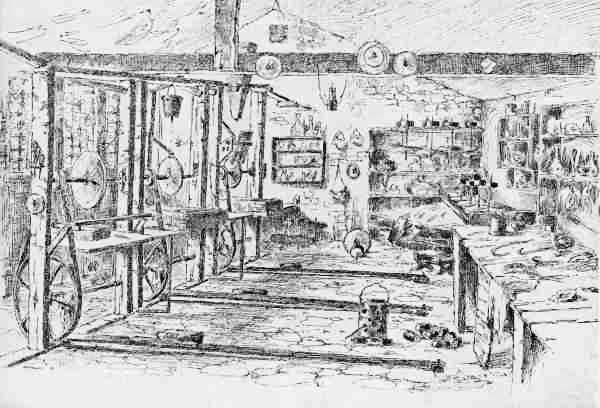

All old glass is interesting, but old Irish glass possesses certain unique qualities which make its collection peculiarly fascinating. In it we find an unsurpassed beauty and depth of colour—a poetry of design and a velvet softness of touch which are a pure joy to the connoisseur. Before describing Irish glass, however, let me first give some idea as to where and when it was produced.
Glass appears to have been made in Ireland to a very small extent during the Middle Ages, and it would seem from the evidence of contemporary records that as early as 1332 the coloured windows of Dublin Castle were made by local workers in Dublin. Some authorities, however, hold that these records refer not to glass-makers, but merely to glaziers, who used foreign glass for their work. What is certain is that the manufacture of glass was not seriously commenced in Ireland until the last quarter of the sixteenth century. Window glass, coloured glass, and drinking glass were certainly made there in 1585, and their manufacture appears to have been carried on more or less steadily from that time onwards in various parts of the country.
History records, for instance, that very early in the seventeenth century a patent was granted to a man named Aston to make glass in Ireland for a period of twenty-one years.
It was not until the second quarter of the eighteenth century that the great period of Irish glass-making arrived, and pieces were produced rivalling, or even surpassing, the best wares of their kind made in England and on the Continent. Unfortunately for the success of the factories, the English Government passed an Act, in 1788, entirely prohibiting the export of glass from Ireland. This measure did more than anything to cripple the great and growing industry, but did not actually kill it, as the makers were not forbidden to sell their goods in their own country!
Irish glass was characterised by what was then regarded as a grave defect. Little or none of it was as colourless as contemporary English pieces, and consequently it did not in those days attain the reputation of the latter. This characteristic, despite the endeavour of local manufacturers to do away with it, appears to have continued for something like a century. Mr. Dudley Westropp, in his important work on "Irish Glass," page 162, mentions a "letter from Exeter, dated December 7th, 1832," in which "Elizabeth Walpole, one of the partners in the Waterford Glass Works, says she had a conversation with Edward Eardley, a glass merchant of Exeter and Plymouth, about some glass she was getting over from Waterford, with a view of selling. She says that Eardley stated that all the Irish glass he had ever seen was dark coloured; but she told him she had sent for some Waterford glass, so that he might see for himself."
This statement throws a light on the somewhat equivocal reputation enjoyed by Irish glass until well on in the second quarter of the nineteenth century, and also shows that at that time the Waterford makers considered that they had entirely freed their metal from the dark tone formerly characterising it. It is indeed a curious irony of human endeavour that the makers of Waterford glass, now deservedly famous for its beautiful and dark grey-blue tone, tried to eradicate it from quite an early date. They endeavoured to make their glass whiter and clearer, like that of Bristol, and in this they succeeded after 1830. The late glass of Waterford, i.e., made 1835 or afterwards, was actually whiter than that of Dublin. Little did these glass artists think that a century later people in all parts of the world would be trying to reproduce the early dark colour without success.
The poor reputation for colour that Irish glass suffered under during the eighteenth century must in itself have greatly interfered with the export trade in the finer pieces. That there was an immense export trade during that period is shown from contemporary statistics, but this appears to have been largely confined to commoner wares, such as bottles, glasses, vials, and other articles in constant use and requiring frequent renewal. The finer and more fragile pieces were generally kept at home. The country gentry considered it the proper thing to support local factories by buying the wares made at them, though they did not always appreciate their purchases, and in many instances supplemented them with imported English glass, which they used in preference. Thus it happens that in many old Irish country houses choice specimens of Irish glass have been discovered stored away in garrets and cupboards practically unused since they were made.
There is little or no documentary evidence to establish the origin of these pieces, for, as a race, Irish land-owners are not addicted to keeping receipts of century-old bills, but tradition and the appearance of the surviving pieces confirm the fact that they were originally of Irish manufacture. It must be remembered that the tradition is the more likely to be true because until comparatively recently Irish glass was only lightly valued, so that it was more to the interest of the owner to consider it of English rather than of native manufacture. The tradition, however, is confirmed by the colour and other characteristics of the pieces. It is interesting to note that in many instances missing pieces in sets have been replaced by later productions of English manufacture. The differences between these and their originals are generally easily discernible, the rich depth of tone, which is such a beautiful characteristic of Irish work, being almost altogether absent from the former.
It must not be thought from these remarks that old Irish glass is plentiful. The commoner wares, such as wine glasses, tumblers, and bottles, which were manufactured in such profusion during the eighteenth century, have practically disappeared; and though a larger proportion of the finer and more valuable pieces, used less frequently and treated with greater care by successive generations of owners, have survived, they are still comparatively rare. Nine-tenths of the so-called old Irish glass offered for sale have no claims to be considered as genuine, but are either old pieces from other countries or modern fakes—chiefly the latter.
From time to time humorists over here state that "no glass was ever made in Ireland," so that the following list of localities where a few of the best known glass-houses stood will be of interest:—
Antrim: (Ballycastle) 1755 to 1790.
Bottles, heavy rummers, and very coarse but useful glass.
Belfast: 1781 to 1870.
Fine flint glass, heavy, rather white handsome deep cutting and very fine bold engraving. Glass was brought here from other parts of Ireland to be decorated. Foreign engravers were employed and excellent work done. Very fine lustres, candlesticks, etc., were made here by McDowell, following chiefly Adam and Georgian designs.
Cork: 1782 to 1844.
Finely cut glass of every description, delicate engraving on blown ware, gilding; particularly famous for its rummers, heavy and light-blown decanters, and, after 1800, whole dessert services of beautiful colour and various cutting. Black glass was made here in 1785, and window glass in 1782.
As the card of membership of the Cork Glass Cutters' Union (shown on Plate I.) proves, "lustre" cutting was popular here.
Dublin: Circa 1630 to 1896.
Window glass was made here from about 1630 and onwards, and as early as 1729 the Round Glass House in Dublin produced choice specimens of glass, such as salvers and dessert baskets, with handles and feet, of particularly fine workmanship and design, but now exceedingly rare and difficult to find. Very beautiful glass was made in Marlborough Street, Dublin, by the firm of Williams, about 1771. They appear to have specialised in chandeliers, candlesticks, salvers, bowls, decanters, bottles, bells, and épergnes. During the last quarter of the eighteenth century and onwards there were numbers of houses here in which every kind of white and coloured glass was made. Many fine specimens still exist, of which Pugh's productions (though rather late) are worthy of note, particularly his "lustre" cutting. The early moulded pieces were very elegant and quaint, very much like Bristol, but so far as I have observed, heavier, and, of course, richer and darker in tone.
Drumrea: (Dungannon) 1771 to 1776.
Much the same kind of glass as Cork, but clearer; noted for fine green and amber coloured glass both in bottles, drops for chandeliers, jelly glasses, wine glasses, and épergnes.
Newry: 1790 to 1847.
A great variety of flint glass, both cut and plain, very heavy. A great deal of table glass was made here.
Waterford: 1729 to 1852.
Produced every possible kind of glass of the most beautiful colour and cutting. The chandeliers, candelabra, boat-shaped and turnover bowls, were perfect. The finest period was just after 1780. After 1830 the glass became much whiter. About 1815 some wonderful deep "step" cutting was done, which made the glass, in some lights, look like silver plate; while dessert services were a great feature, and I constantly come in contact with parts of these services (tucked away in cellars and odd places) of the most surprisingly beautiful workmanship and colour.
Portarlington: 1670.
One of the very earliest glass-houses was erected here on the Stannus property, but very little is known about it or its particular productions, and it closed down in a few years from lack of financial support. I believe drinking glasses were its chief output. We have a tumbler which was made here, and some wine glasses are still in existence.
Foreign workmen were employed in Ireland, particularly cutters, engravers, and gilders. Irish gilding almost stands alone. It is very hard, and cannot be rubbed off in the usual way. When deliberately scraped off it leaves the glass underneath quite rough, consequently it has survived ordinary wear and tear almost intact. The process was chemical, and it is a great pity that more of it was not done. Very fine soft oil gilding was executed for some years, about 1786, by a German called Grahl.
The glass industry died out about 1896, Pugh, of Dublin, being the last maker of flint glass in Ireland. He is often credited with being the first to introduce "lustre" cutting, but the rare plate of the Cork Glass Cutters' Union, already referred to, shows that this decoration must have been done in Cork early in the nineteenth century, since it may be presumed that the pieces they have chosen as being representative of their own craft would be those most largely produced. The fine old jug in the centre, for instance, is a splendid specimen of "lustre" work. Some people, other than glass-cutters, refer to this as "pillar cutting"—quite a good description.
While on the subject of the workers, it will be of interest, in these days of high wages, to recall the remuneration paid to these artists in glass as recorded in the Dublin Museum. The founder received the princely sum of 7s. for his week's work, while the fireman only got 6s. The glass-maker himself (not the cutter or the engraver) was evidently a piece-worker, earning at most 50s. a week, and was doubtless a mighty wealthy man.
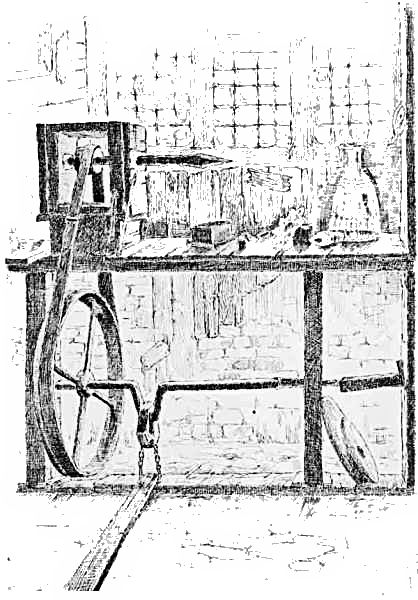
Naturally the extraordinary cheapness of fuel in Ireland was a great help to the owner of a glass-house, as wood was the chief thing he burnt. But late in the seventeenth century an Act was passed prohibiting the felling of trees for this purpose, so even in those early days manufacturers had their troubles. However, I do not think this interfered very much. If an Irishman wants a thing, it takes a great deal more than an Act of Parliament passed by the Englishman on the other side of the water to stop him.
As late as the nineteenth century, in my father's time, our village carpenter would come and buy a good-sized ash tree for 1s. 6d. Those not so well off freely helped themselves by the light of the moon. We do not bring people to justice in Ireland for little slips of that sort: we should have no time left to ourselves if we did.
Very simple and primitive were the instruments used by the glass-cutters. Speaking broadly, the artist (for he was an artist) merely required revolving wheels, from 2 in. to 14 in. or 16 in. in diameter, sand, water, powdered pumice, and "putty powder," a mixture of whitening and other ingredients for polishing.
The wheels consisted of "mild steel" for cutting (many sizes), a "blue stone" wheel for smoothing, and one of very hard wood for polishing. Brush wheels were also employed.
The illustration of a very primitive glass-cutter's shed (from a drawing in my possession) will explain better than words how the work was done; the wheels were turned by the rough boards worked by the cutter's foot, while with his unerring hands he would perform marvellous feats of glass-cutting. Water and sand dripped slowly on to his wheel while he worked, generally from a flower-pot hung above.
He worked from a rough design on paper beside him, and this design he first scratched on the piece of glass with a sharp instrument. Much of the glass-cutting was done outside the glass-houses by men who had their cutting sheds in their own homes, as is shown in the illustration, and this accounts for the "individuality" of the work done. These men, dreamers and artists, were a "guild" with a very high ideal. The old Irish silversmiths also worked at home in a similar fashion, and, as all the world knows, executed the most perfect work.
In these days it is interesting to know that a strike ended the industry in Cork previous to 1840. Some English workmen came over and told the Cork men they were working too cheaply, though in fact they were much better off than those in England (where machinery was now well installed). The glass owners, who had become wealthy, but saw little prospects of retaining their fortunes under changed conditions, fought the men, and eventually closed down their factories.
Those in Waterford continued for some years later, and the last record of this town is in the catalogue of the London Exhibition of 1851, where Gatchell had some wonderful exhibits, including one centrepiece of forty pieces of glass for a banqueting table, no metal work of any kind being used in it.
In 1788 William Penrose made a celebrated service for their Majesties. And as early as 1729 beautiful deep green glass was made at Waterford.
Interesting and romantic were the tales told by the last of the hand glass-cutters, Barry Sheehan, who died a very old man in Cork in 1890. He knew all the old glass-cutters, was an artist and enthusiast, and always kept an old hand-cutting wheel at the back of his shop, a relic of a past age of inspired workers.
According to this great authority, "lustre cutting" was the most difficult of all, and very popular in Cork.
One old lady who lives in Cork, a sister of the late Mrs. Gatchell, who is nearly 100 years of age, has a set of chessmen in old Irish glass, and many children's toys and trumpets were made in her late husband's factory.
One of the glass-houses in Cork was owned by "honest Joe Romayne," one time M.P. for Cork, and another by a family named Foley, and the descendants of both of these people have some splendid pieces still.
Engraving was a different matter. This decoration was more often done by men (chiefly foreigners) who wandered round the country carrying with them a queer little box (one of which I have in my possession). A few delicate copper wheels were used outside the box, which were driven by a shaft, and two wheels inside. The handle was turned by a boy while the engraver worked.
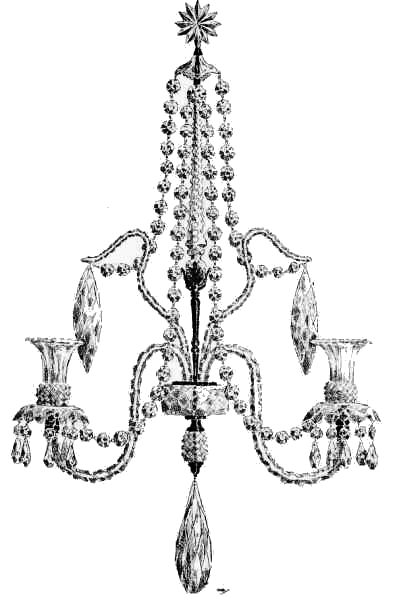
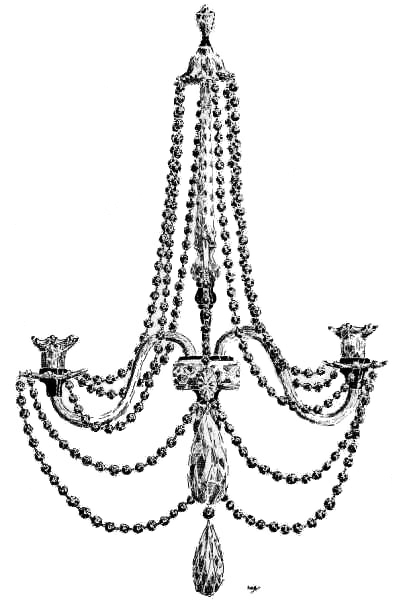
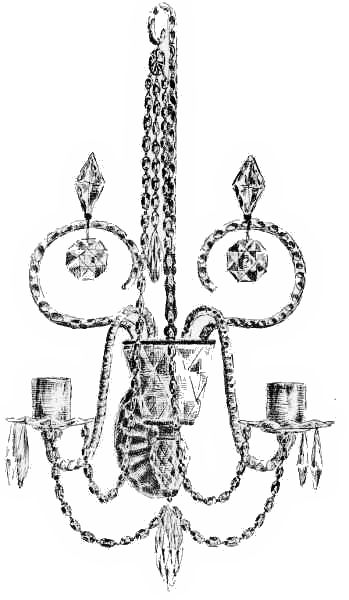
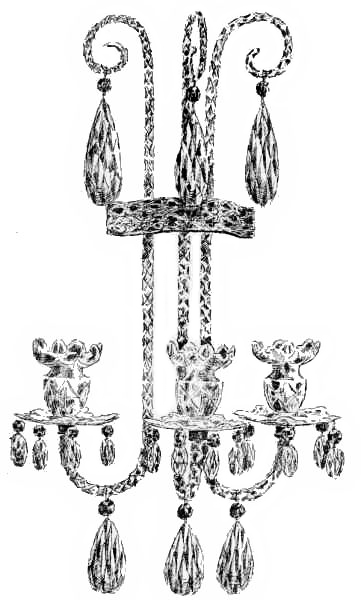
Candle-lights became very popular during the early Adam period, and continued to be made for many years. Their conception was, I am sure, French in its origin. A great many were made in Ireland (especially advertised in Dublin), and they were permeated with Adam feeling—graceful and simple.
These lights fell into disuse when gas became popular, and were stowed away in boxes and cellars and lumber-rooms; while others, still less fortunate, were actually thrown away or sold to the ragman for a few shillings.
Of those I have unearthed, a great number are in varying degrees of bad and good condition, and it is most interesting, with the aid of some original drawings (which I am fortunate enough to possess), to reconstruct these lovely fittings to their original beauty (see Plates IV., V., VI., VII.). Out of about five or six broken lights I can generally reconstruct one pair.
In my determined search for these treasures, I find that the metal back plates which fitted on the wall and held the glass lights are in nine cases out of ten missing, and after puzzling over this fact for some time I discovered they were nearly always utilised by being left on the walls and the gas-pipe brought through them! In any case, all the metal mounts appear to have been removed from the branches, cups, etc., and I think they were probably taken off and used for various purposes by the "house-carpenter," or handy man, and held far more value for him than the discarded glass, which is now rapidly becoming priceless.
In one instance I lost the ferrule off the end of my whip, and one of our men said he'd "put it right." I noticed a fine bit of chased brass appear on it. I said, "Larry, where did you get that?" "Shure, me lady, it's off th' auld glass light that was tooken from t' hall"! And it was! Irishmen have natural instincts—they always know a good thing, and they can unerringly tell you if a person is "someone" or not!
There are many interesting things to be learnt about the drops which hang on chandeliers and table lights. The first and most surprising is that most of them, even those found on quite early Irish chandeliers, were made in England and France! Very few were manufactured in Ireland.
The genuine old Irish drops (so far as my personal observation and experience goes) were always round or almond shaped. The most characteristic distinction between them and those made in other countries is that they are very flat when viewed sideways (see illustration No. 3, page 8), whereas the English and French come to a point in the centre—sometimes on one side, more often on both—not a sharp point, of course, but still a point (see illustration No. 4, page 8, which will make the difference quite clear). No. 1 (page 6) is a very rare specimen.
All the chandeliers and lights made for my family had in every case these Irish drops, being, of course, special orders. When seen on a chandelier it is remarkable how much more graceful the Irish drops look; they are softer, more richly facetted, smoother, and, of course, deeper in colour. The large pendants (see illustrations Nos. 2, 5, 6, 7) for ornaments and stars for chandeliers were manufactured in an interesting way. They were made in ladles, designed to the required outline and size, with a long handle (see illustration below). The ladle was dipped in the pot of molten glass, withdrawn full, and after being allowed to cool slightly until the glass had set, tipped out into a "dry" furnace (known as a lehr) for some hours; by that time the glass was hard and fit to be facetted by hand.
In Italy and Spain I have watched the glass-makers at much the same work, but in these instances the glass was made in cut moulds, so that the glass was pressed into a pattern while hot, and not cut afterwards.
The illustrations are of Irish ornaments in my possession on family chandeliers, and vary in length from 5 in. to 8½ in.
Irish glass, more especially Waterford, of the typical period, may be distinguished from contemporary English glass and foreign and modern fakes of all nationalities by a number of characteristics which may be grouped under the headings of Weight, Colour, Resilience, Feeling to the Touch, and Ring. Let me take these one by one.
Irish glass is generally very heavy, though there are exceptions to this rule, markedly in the blown specimens from about 1735 to 1750, which are extremely light. These pieces were never cut, but either engraved only or left perfectly plain. They can be distinguished from foreign pieces of similar weight, as they never show the little specks of sand in the metal peculiar to the latter. On the other hand, air-bubbles often appear in the Irish glass, which were caused by the faulty stirring of the molten metal. These are sometimes so minute that they appear like sand specks to the naked eye, and it is only possible definitely to identify them as bubbles by the use of a magnifying glass.
All old Irish glass has a peculiar depth of tone, but the early glass of Cork, Waterford, and Dublin is especially distinguished in this quality. Its steel or grey-blue tone is unique. In this respect there is very little difference between the wares from the three places, as they are all characterised by the same mysterious grey colour (supposed to be caused by impure ingredients). It should be remembered that the factories in all three localities obtained their materials for glass-making from the same sources, and that the workmen employed in them frequently passed from one to another, so that, theoretically, the metal produced in the three towns should be practically identical. There are, however, tangible differences in at least a portion of the glass emanating from the various localities. Thus I have noticed that some Cork glass has a decided yellowish tinge which Waterford never has. On the other hand, Waterford glass is often distinguished by a peculiar cloudy bloom covering the metal, which can be rubbed off, but will assuredly return. This "bloom" must not be confused with the milkiness found in decanters, etc., which is caused by wine or water being allowed to remain in them for long periods. It is quite different: a soft bloom, exactly like that on grapes, the same colour, or even darker, than the glass, and often will be found forming a beautiful band of rainbow hue running round the piece it adorns. I do not know, for certain, the cause of this appearance, but it probably originates in some atmospheric action on the lead in the metal. It is only found on very early dark pieces, and its possession may be regarded not only as an additional charm of the piece so characterised but also as a proof of its authenticity. These pieces are most interesting, but are not always appreciated as they should be. Some time ago I parted with a magnificent Waterford bowl, beautifully toned in this manner, only to find a week later that it had been chemically polished clear and bright, leaving it with not a tithe of its pristine beauty.
These distinctions of tone and colour which I have ventured to point out are by no means universal, so that a piece which does not possess them must not be rejected as spurious merely on this account. Sometimes it is impossible to say from what county a piece came, and this has led experts to refer to the products supposed to emanate from the Cork or Waterford factories as "Munster glass." Even this term is not broad enough, however, for it fails to include the pieces turned out by the Dublin factories, and these are nearly as likely to be mistaken for Cork or Waterford wares, as the two latter are likely to be mistaken for each other. The blue-grey tinge popularly regarded as exclusively associated with Waterford glass is quite an erroneous means of identification, as most of the pieces I have come across, actually impressed with the mark "Cork Glass Co.," were of this tint. Dublin glass, before 1800, was very dark in colour, and the very early pieces are almost black.
It is very frequently suggested that the chemical action of the air on old Irish glass may have something to do with the mystery of its unique coloration; and, strange as it may seem, it is an undoubted fact that glass does change its tone with the slow lapse of years. I believe this to be specially so with Irish glass which has remained a long time in Ireland; and the existence of such phenomena is borne out by the effect that the atmosphere of Ireland has on old white marble. It may be argued that, should this be the case, the coloration of Irish glass may be caused entirely by the atmospheric conditions under which it is kept, and owe nothing to its local peculiarities of manufacture. This theory, however, cannot be substantiated, as English glass does not appear to be affected by Irish atmosphere to anything like the same degree as the native metal. I have frequently seen old Irish dessert services and chandeliers in which individual pieces which had been broken had been replaced by facsimiles made in England. These replaced pieces, however early their origin, do not appear to have changed colour in the least, and because of this can be readily singled out among their fellows of native manufacture.
Irish glass is far tougher and stronger than any other, hence its wonderful survival even when in constant use. It takes a severe blow to break it, or even chip it, and I have seen solid pieces fall on a hard floor without being any the worse, beyond "singing" loudly. It has a wonderful elasticity, and actually bounces in a way that I have never found in any other glass. Some time ago the ring securing a large and valuable chandelier to the ceiling of one of my rooms gave way, with the result that the chandelier fell to the ground from a height of twelve or fifteen feet. It was, of course, broken with the fall from such a height, but the centre pendant, a large solid lump of lead glass, weighing 9 lbs., had not been shattered in the least, though the force of the fall had flattened its point.
Irish glass does not feel harsh or cold like most English or foreign, but gives a sense of soft warmth to the touch. There is something of the same distinction as between porcelain and earthenware, though not nearly to such a marked extent. One has to acquire a knowledge of it by experience; and though the tyro may at first perceive little or no variation between the feel of Irish and English glass, if he will cultivate his sense of touch by handling authenticated pieces of both varieties, he will soon find that there is a small but perfectly distinguishable difference between them.
I must make special mention of the ring of Irish glass, as this is an important point. All British glass has a clear, definite, bright ring, but to anyone with a musical ear it will be interesting to listen to the peculiar throb in Irish glass, not so much a ring as a rich throb, sometimes (particularly in large pieces) like a vibrato between two notes. I do not say that you get this in all Irish glass, only in the greater part of it.
No one, for instance, would expect a candlestick to ring or a salt-cellar, or a thick shallow piece heavily cut. Jugs, as a rule, also have a special dislike to displaying their voices, so, naturally, people must use their discernment.
This peculiar ring of Irish glass is not to be found in glass of alien origin. The foreign copies are quite different. Sometimes they will not ring at all, especially the wine glasses; the better ones give a sound of sorts, but it is very dead, and, if carefully listened to, the note is never true, just a little flat, quite unlike the "singing Waterford."
These are innumerable, and belong to all periods, old and modern, since Irish glass first became popular.
No glass in the world has been so much copied, and none has, in the long run, stood out so successfully in defying the faker. This constitutes one of the great attractions of Irish glass to the collector, for though many imitations of it have been made of sufficient excellence to deceive the inexperienced and unwary, it cannot be copied sufficiently well to deceive the connoisseur.
The finest reproductions from France, Belgium, Holland, and even Germany, all fail in colour and texture, though some of the cutting is exceedingly clever.
At the present moment there is an enormous amount of spurious glass on the market, and some time ago a lot of remarkable copies were in circulation. They were the best that have yet appeared, especially the urns and candlesticks, and numbers fell into the hands of the unwary. One special weakness, however, was very noticeable—the colour fell in the tall pieces, leaving the tops whiter than the bases.

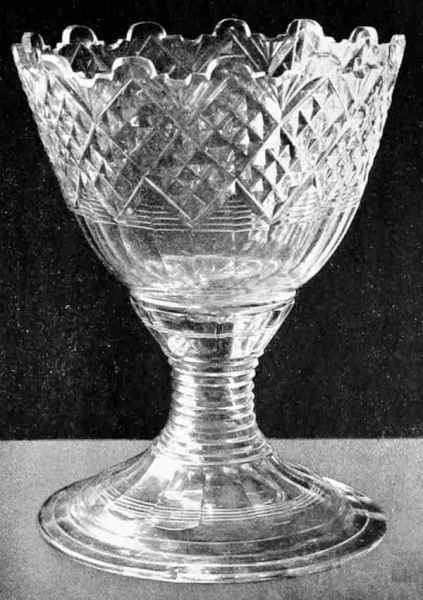
At the present moment some very clever reproductions from Bohemia are arriving in England, but they are very light and have a peculiar pink tinge, which is more specially noticeable in the larger pieces.
As has already been pointed out, nearly all Irish glass is heavy, and a very large proportion of the modern fakes fail to attain the required weight. A marked exception to the general rule of weight is to be found in Irish blown specimens, produced from about 1735 to 1750, which were very light, and only engraved or quite plain, never cut. The faker frequently forgets the latter point. When, however, he remembers it, and produces plain or engraved pieces similar to the Irish, there is yet another point of distinction. The Irish pieces often show air-bubbles, but never the little specks of sand which, as I have already said, almost invariably appear in the metal peculiar to foreign glass.
The most important distinction between Irish glass and foreign imitations is to be found in their colours, and in this respect it is the early glass of Cork, Waterford, and Dublin that defies the copyist more than any other. Its steel or grey-blue tone stands alone, although, alas, imitations artificially coloured with thin cobalt and ultramarine have been, and in all probability will continue to be, sold as the genuine article. In the analysis of Irish glass there is no trace of cobalt.
Some copies of an almost emerald green have changed hands in good faith as Waterford glass. How could green be produced from lead oxide, potash, soda, and silica?—for this is the analysis of an early piece of Waterford "pot metal" glass of the dark grey hue.
The multitude of fakes on the market bears testimony to the increasing demand for Irish glass.
During the last six years, those members of the public who have a knowledge of glass have realised more and more the value of the genuine Irish article, which, of course, is due to the fact that it cannot be copied sufficiently well to deceive the connoisseur. The direct outcome of this is a steady increase in the market value, and rare specimens, which were made at from 25s. to £4, now readily fetch anything from £10 to £400; in fact, a single piece sold recently for £750, and a beautiful bowl passed through my hands at £550; while only a few months ago a chandelier was sold at an Irish auction for £1,218.
Magnificent specimens of Irish glass have found their way into English collections, as will be seen by the plates shown in this book. Photographs of most of the well-known pieces in the Dublin Museum, and in private Irish houses, have already been reproduced in various publications; but the accompanying photographs are of exceptional specimens, taken exclusively from English collections, and a very large number of them has passed through my own hands.
It is absolutely impossible to become a sound judge of Irish glass without years of experience, and, above all, without the constant actual handling of pieces of all dates and descriptions, consequently the genuine Irish dealer who has lived amongst it all his life has a very great pull with regard to actual knowledge.
So many specimens were made to order, and were therefore of special shape and cutting, that it is very difficult for the uninitiated to recognise a piece as being of any certain factory or period, and he is naturally mystified when he tries to classify such pieces into more or less well-known categories. For instance, an ancestor of mine had in his possession an early deep coloured bowl, cover, and stand of exceptional quality, made about 1750. His son, in 1790, had it cut in "flat diamonds" (a cutting then much in vogue), the result being a specimen of early dark "wavy" glass, adorned with the beautiful cutting of forty years later, and this is only one instance of many which could be quoted.
Great quantities of Irish glass were made, and the official Irish records show that large numbers of pieces were exported to America, Spain, Portugal, and the West Indies, etc. Many of our finest specimens were also taken to Holland, where they found a permanent home, and were extensively copied by the foreign glass-makers.
France was very keen on Irish glass, and I have unearthed there some very lovely and absolutely genuine specimens, especially wall-lights and chandeliers.
Needless to say, a very big trade was done by the glass-houses direct with old Irish families, who gave large orders for glass-ware, ranging from single pieces to complete table services, of which few records appear to have been kept.
A large amount of Irish glass was made and put by, uncut, as Irish families (especially those who lived near the glass-houses) preferred to choose their own cuttings from drawings, so as to have something different from their neighbours. This accounts for the number of uncut pieces still to be found in various parts of Ireland, especially thick finger-bowls, which were, undoubtedly, made in great quantities to await orders.
The following plates give some idea of the beautiful pieces of glass which have left Ireland, but there are magnificent specimens still there, which will probably never be placed on the market—pieces as poetic in design as their owners are in mind; pieces that will live for the sons and heirs to love and cherish with the many other treasures of Ireland's finest periods, long after Sinn Feiners have ceased their endeavours to destroy all that is best and loveliest in the old country.
At the time of writing this, I find an enormous amount of spurious "Irish" glass on the market, and I take this opportunity of warning all collectors and dealers (many of whom are my friends) to be exceedingly careful. It is essential that all lovers of Irish glass should keep their collections pure, and some of these fakes are so clever that dealers will have to exercise the greatest vigilance and care if they are to avoid the ignominy of having pieces which they have sold in good faith returned to them as "wrong." At the present time, all the best known dealers in Irish glass are trusted by their customers, and their advice is taken without question. It is in the best interests of their great profession that this sense of confidence should remain.
In conclusion, I should like to add that I hope this book—written, as it is, at the request of many lovers of Irish glass—may be a real help to the novice, and assist him to distinguish between the "true" piece and the forgery.
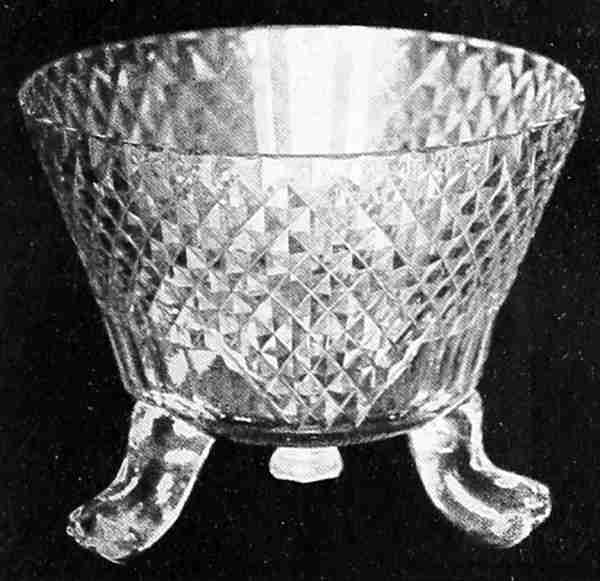
Waterford Bowl, circa 1783. 8 in. by 10 in. Very flat diamond cutting, on three feet carved as paws. This bowl, which is one of the finest the author has ever seen, is exceptionally notable from the fact that the pontil has been worked up into an ornament instead of being broken off.
In the collection of Commander Swithinbank.
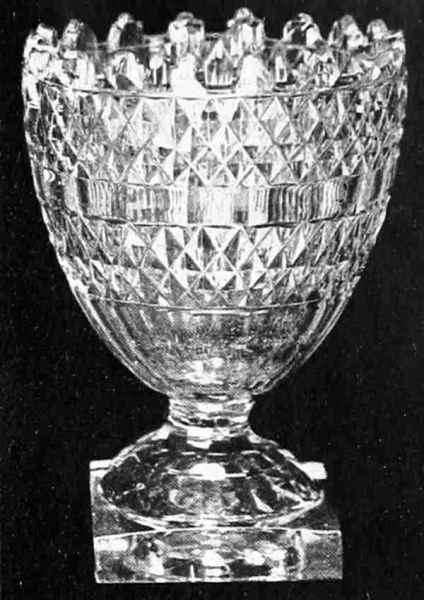
Waterford Flower Bowl, 12 in. high. Heavy early glass, finely cut, with castellated edge. Circa 1783.
In the collection of Commander Swithinbank.
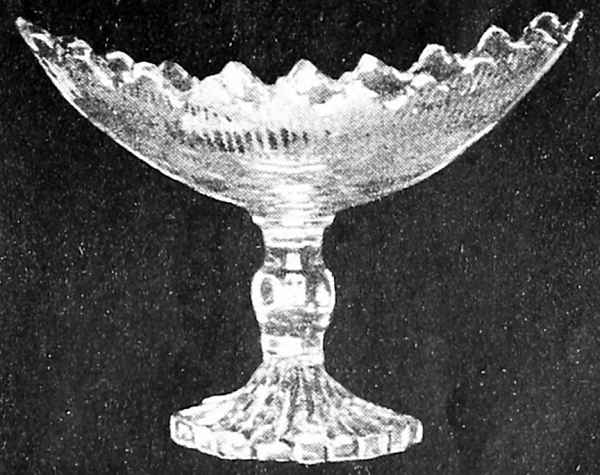
Waterford Canoe-shaped Bowl, deep colour and rare shape; 1783. 10 in. high, 14 in. wide.
In Viscount Furness's collection.
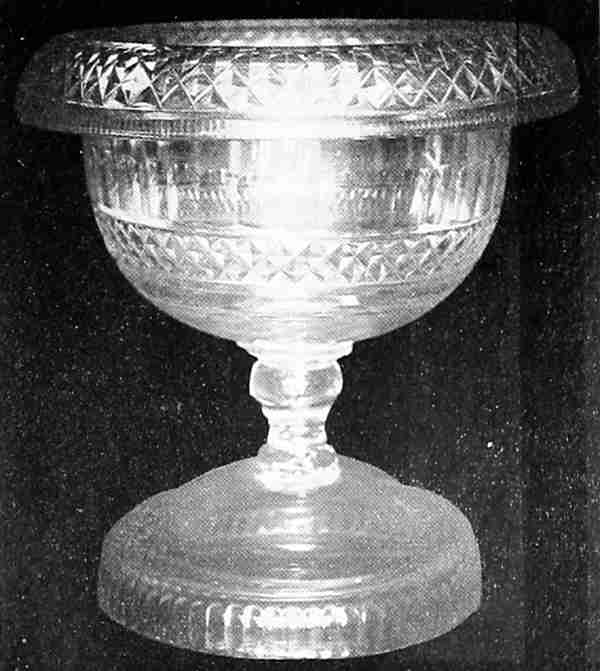
An exceptionally large "Turnover" Cork Bowl, on heavily domed base; early. Flat cutting. 12 in. high.
In the collection of Mrs. Rea.
A similar example is in the Walter Harding collection.
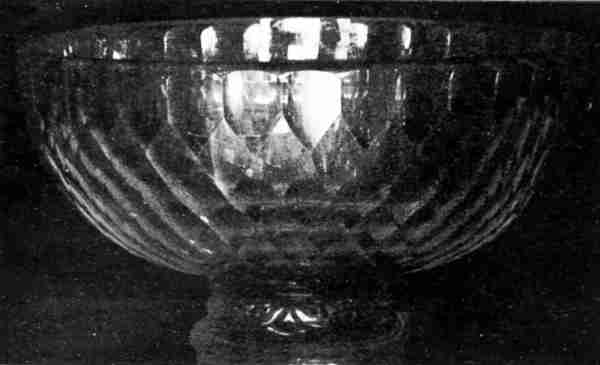
Rare heavily chiselled Christening Bowl. Irish, 1760. 26 in. across.
In the Author's collection.
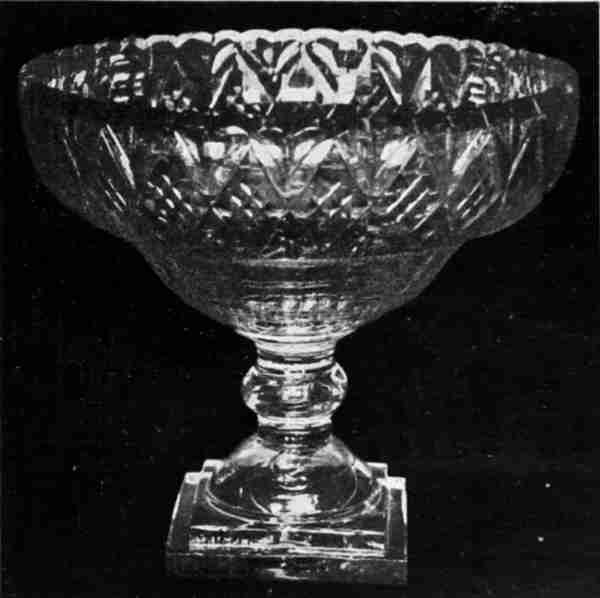
Munster Glass Bowl. 10 in. by 11 in. Circa 1780. Heavily but beautifully cut.
In the collection of Mrs. Hall.

Very large early Irish Moulded Bowl. It rings exactly like a bell. Deep coloured and very soft glass. No duplicate known. Date 1760.
In Mrs. Rea's collection.
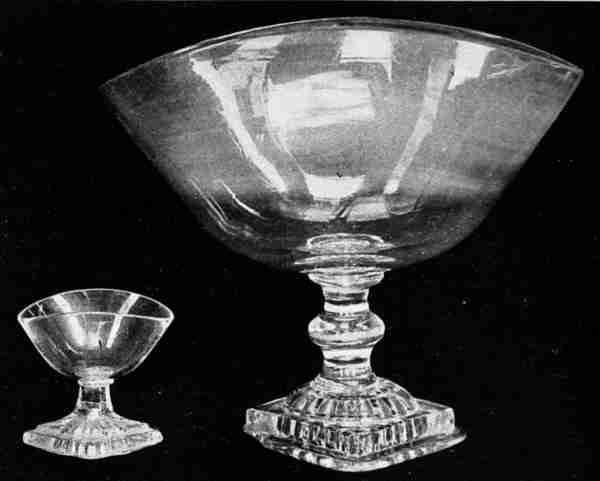
A wonderful early "Pinched" Bowl, showing the remarkable "rainbow" band of faint colour running round the body. The foot is square and moulded in a "dome." Note that the waste metal running from the square base has not been cut away, proving that this piece, for some reason unknown, has been left unfinished. There is no trace of "milkiness" about this bowl. The small one (3 in. high) beside it is a traveller's sample, made this minute size for convenience in carrying about.
In the Author's collection.
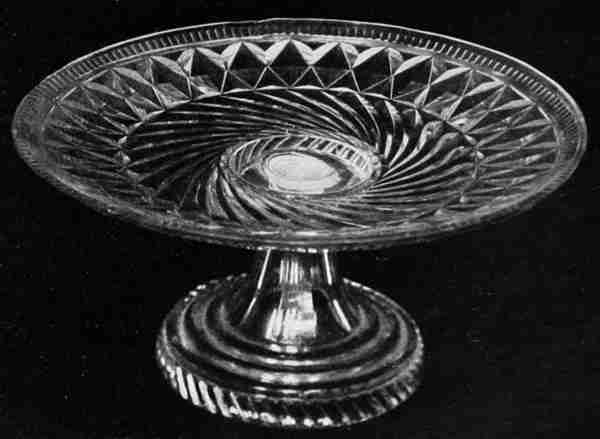
Shallow diamond-cut Waterford Revolving Centre Dish, 18 in. by 6 in. The glass all fits together without any metal mounting. Circa 1783.
In the Hon. Mrs. York's collection.
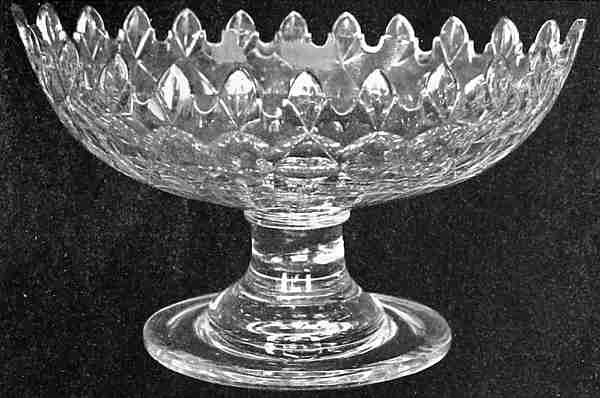
Rare specimen of Cork Glass Orange Bowl, circa 1790. 14 in. long, 8½ in. high.
Originally in the Author's collection; now in the Walter Harding collection.

Early Cork "Pillar" Bowl.
In Viscount Furness's collection.
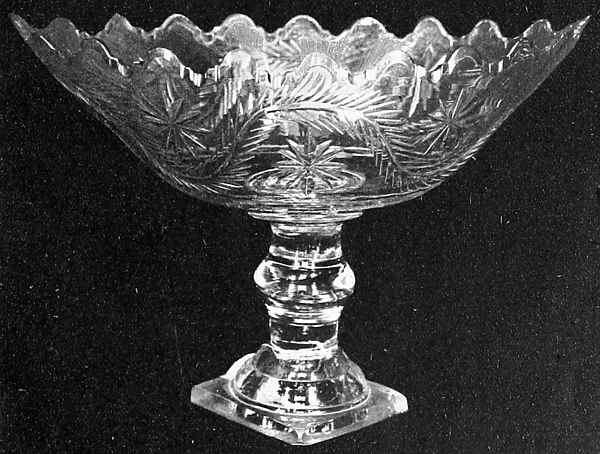
Large Bowl of exceptional shape, colour, and cutting. Knopped stem. Circa 1785.
In the Author's family collection.
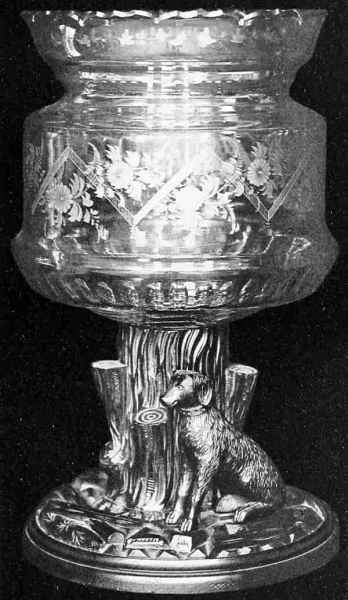
Curious specimen of early Irish Glass, engraved. Of a beautiful deep colour. The stand is of Irish bog-oak, Celtic carving, the Irish wolfhound being very carefully executed. 18 in. high.
In the collection of Commander Swithinbank.

Large Two-handled Posset Bowl, 18 in. high. Possibly
as early as 1750. Irish.
In the collection of Mrs. Hall.
Rare heavy, dark, plain Ogee Bowl, 11 in. by 11 in.
Irish, circa 1760.
In the collection of Mr. Robert Frank.
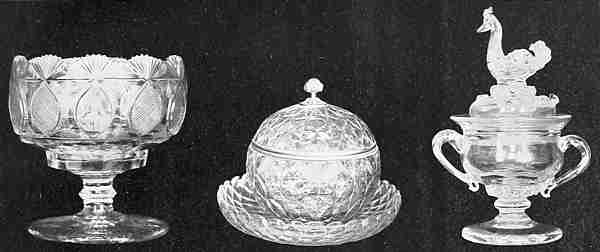
Strawberry and Fan Cut Bowl, 8 in. high. Made at
Waterford in 1790, and bearing the Stannus crest,
finely engraved.
In the Author's collection.
Waterford Bowl and Basin, cut all over with large,
flat double stars. 11 in. by 12 in. Circa 1783.
In Mr. Wild's collection.
Two-handled Cup and Cover, heavy clear glass. 4 in.
high. Circa 1780. Dublin (copy of Bristol, but much
heavier).
In Mrs. Day's collection.]

A giant "Turnover" Round Bowl and Dish. Bowl, 12 in. wide; dish, 20 in. Waterford, circa 1815.
In Mrs. Rea's collection.
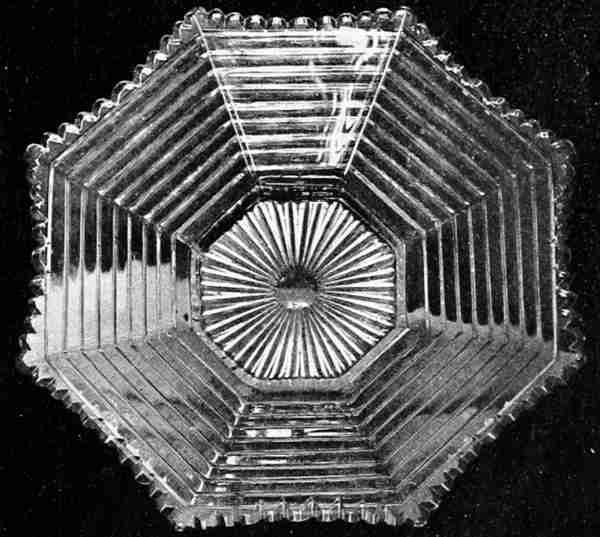
Octagonal Deep "Step" Cut Waterford Dish, 12 in. Circa 1825. A very unusual specimen.
In Mrs. Oliver's collection.
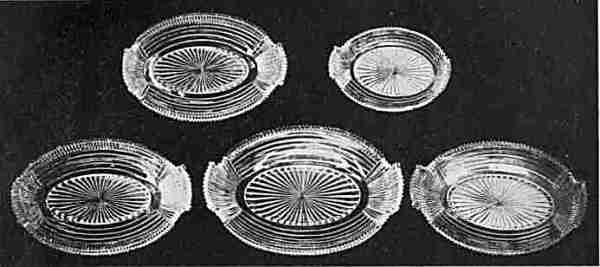
Set of "Step" Cut Dishes with fan handles. Waterford, circa 1820.
In the collection of Mrs. Hall.
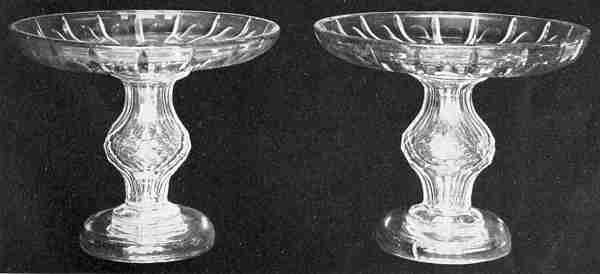
Pair of Banqueting Tazze, Munster glass of about 1790-1810. Made of heavy dark glass in one piece, with a heavily domed foot, and finely cut in slash and diamonds. They are 13 in. high, and weigh 32 lbs. each.
In the collection of Mrs. Hall.
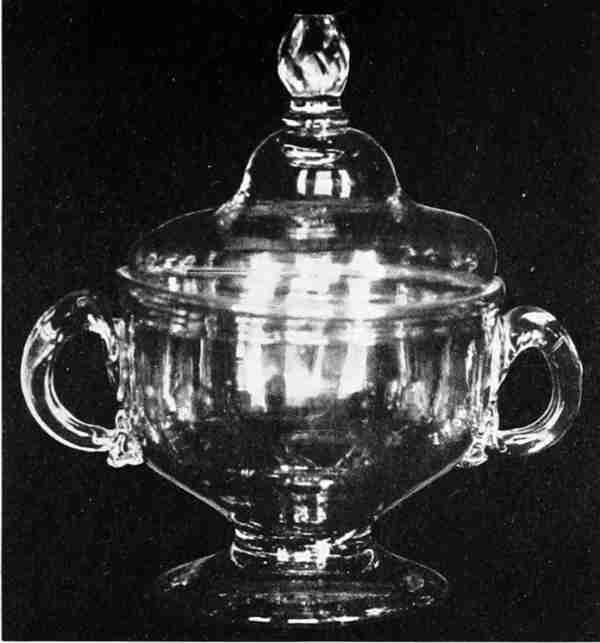
Early Irish "Posset Bowl," probably 1730. Heavy glass of a beautiful dark colour.
In Mrs. Rea's collection.
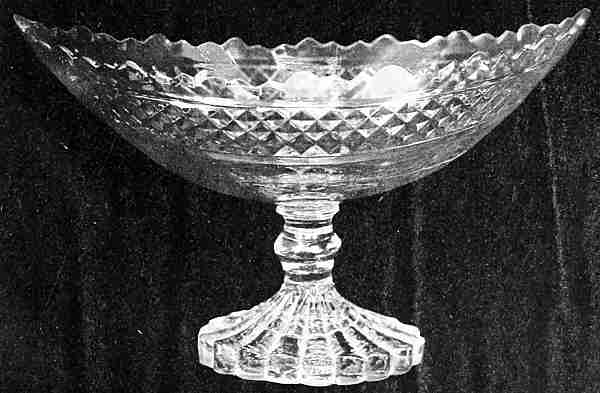
Waterford "Canoe" Shaped Bowl, on scroll base, 1790. 14 in. long, 9 in. high.
In the Author's family collection.
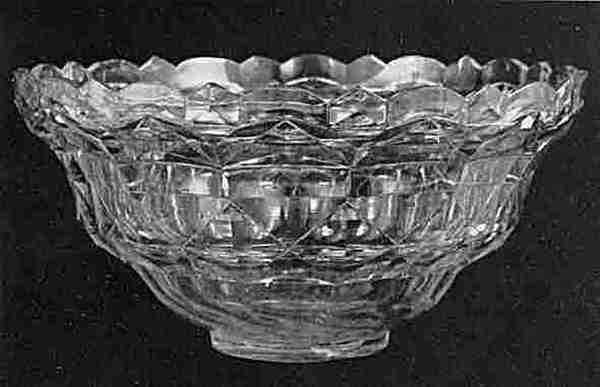
A beautiful Waterford Salad Bowl, circa 1785. 12 in. diam., 5 in. high.
In Colonel Fitzgerald Stannus's collection.
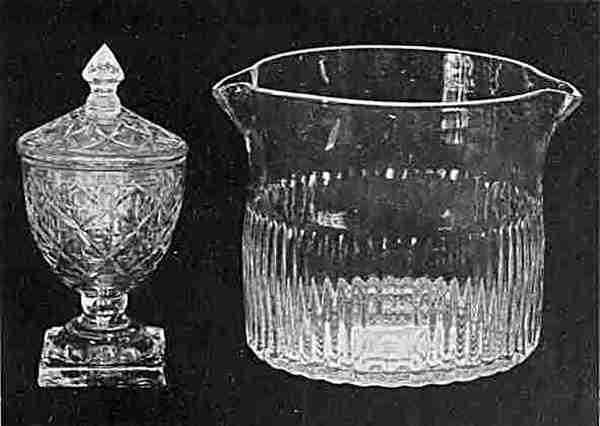
One of a pair of heavy
Urns, very early Dublin.
12 in. high.
In Mr. Hugh Weguelin's
collection.
A rare Finger Bowl, marked "Dublin," very
dark colour and soft glass. An early piece.
In Mr. Robert Frank's collection.
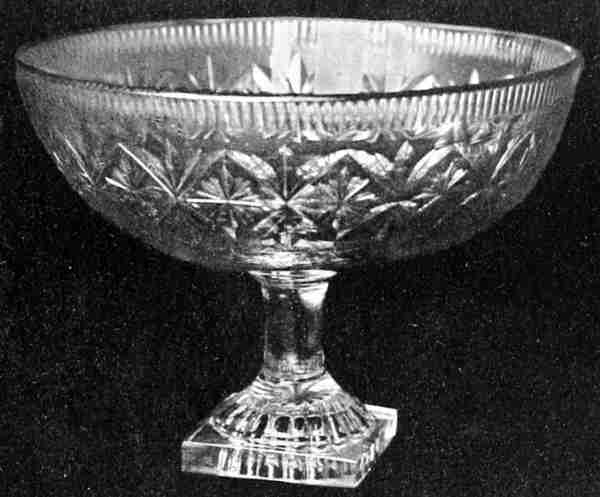
Round Cork Bowl, of beautiful colour and ring, circa 1785.
In Mr. Henderson's collection.
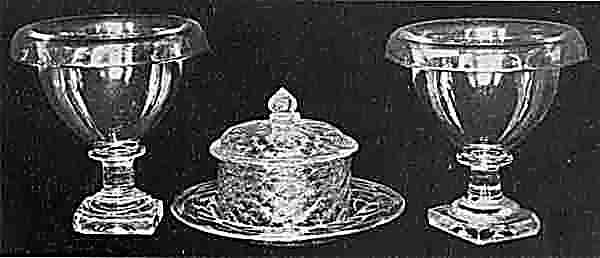
Three rare specimens of very early Irish Glass. The pressed piece in the centre is particularly beautiful in colour and texture, and the two vases are very heavy, probably early Dublin, with unfinished feet.
In Mr. R. Philipson's collection.
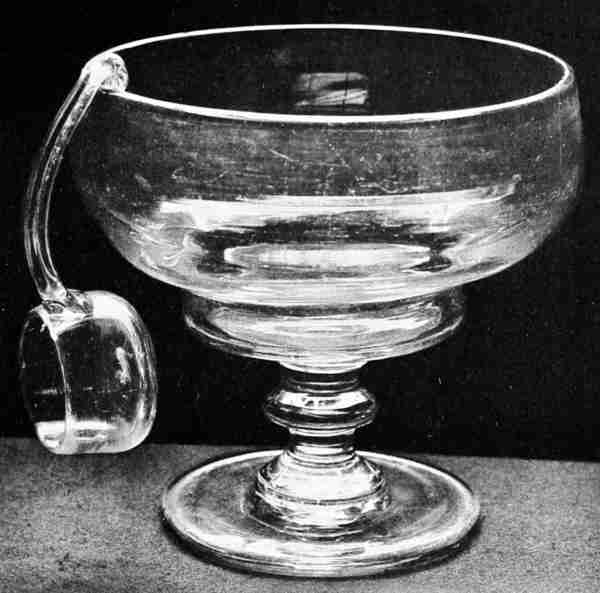
Irish Plain Punch Bowl and Ladle, heavy uncut glass of fine colour, circa 1770.
In Mr. R. Frank's collection.

Fine examples of the later period (after 1815) "Step" Cutting Waterford. This glass is whiter and much clearer than the earlier examples.
In the Author's collection.
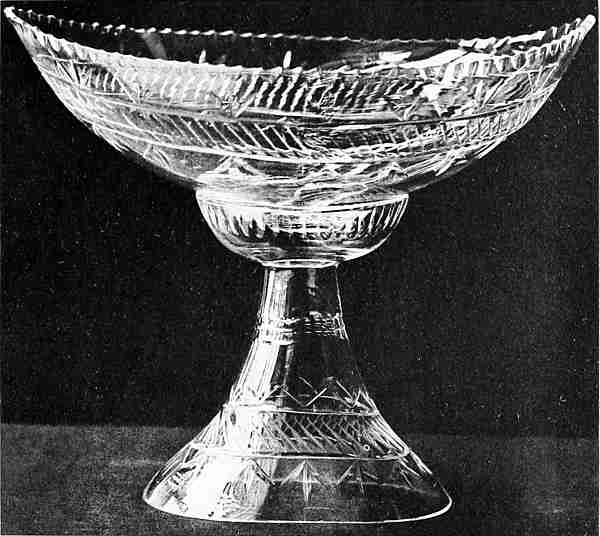
One of the rarest Waterford "2-Piece" Bowls in existence, circa 1785. 12½ in. high, 10 in. wide, 14½ in. long. Remarkable for its colour and texture.
Originally in the Author's collection; now in the Walter Harding collection.

Waterford "Helmet" Bowl, very rare, and a pair of large, finely cut oval Waterford Dishes. Adam period.
In Major Courtauld's collection.
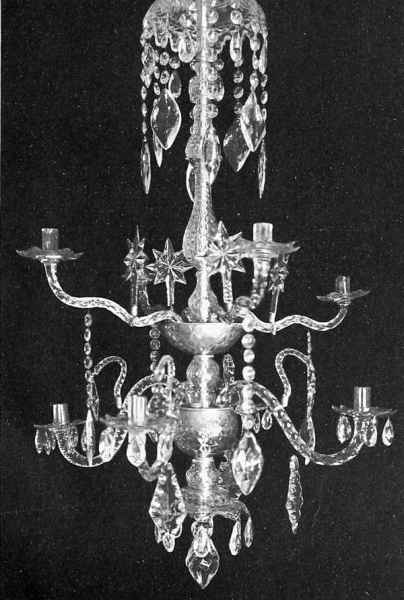
Original Chandelier, made at Waterford in 1785. 6 ft. 3 in. long. The upper trio of arms are "hand bent," and the stars on these arms are 6 in. high. The pendant at the bottom weighs 9 lbs.
In the Author's family collection.

Original Chandelier, made at Waterford in 1788. 6 ft. 6 in. long. The arms are each 2 ft. 8 in. long, and it weighs 2½ cwt. The cutting, workmanship, and colour are unsurpassed. It is built upon an iron rod covered in silver tubing.
In the Author's family collection.

A Waterford Chandelier of exquisite design and cutting. 4 ft. 6 in. long.
In the Author's collection.

Pair of Waterford Sideboard Lights, of the finest period and rare cutting. Adam design.
In the Author's collection.
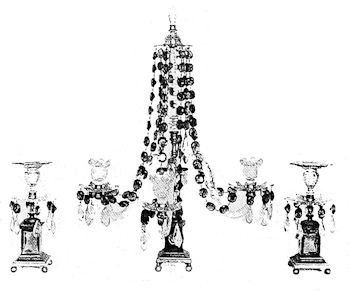
Waterford Glass Chimney Set, draped with deep "pot-metal" blue drops. 20 in. high. Probably Dublin, circa 1815.
In the Author's collection.

Set of three Waterford Table Lights, 26 in. high.
In Viscount Furness's collection.
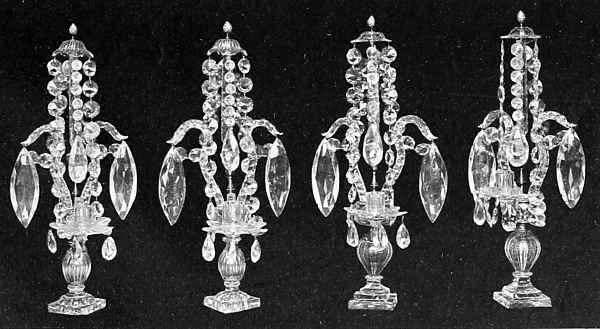
Rare set of four single Dining Table Lights. The facet cutting on the long "reflectors" is particularly fine and interesting. Waterford, circa 1785.
In Viscount Furness's collection.

One of a pair of Adam Lights, 4 ft. high. Waterford glass, on old marble "Bosi" work pedestals. Slightly restored.
In Viscount Furness's collection.
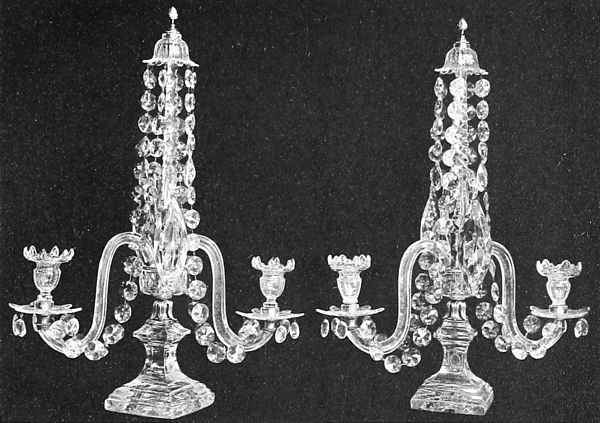
Typical pair of Irish Table Lights, 25 in. high, on square bases. Circa 1780.
In the Author's collection.
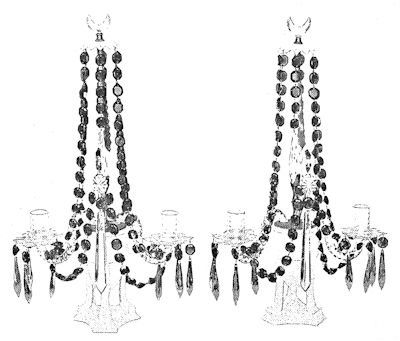
Pair of Waterford Table Lights, hung with the palest amber round drops (Dublin), and mounted on Wedgwood urns. 22 in. high. Late Adam period.
In Mr. Hugh Weguelin's collection.
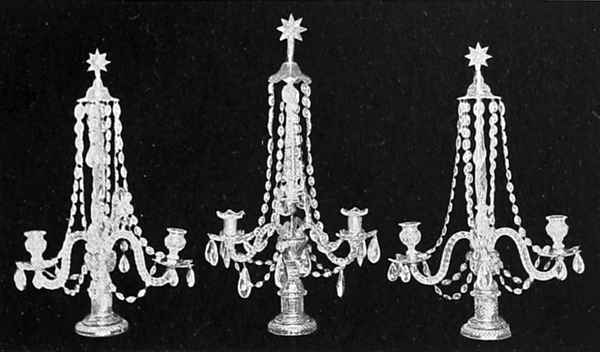
Three Waterford Facet-cut Table Lights, with almond-shaped drops, 22 in. and 23 in. high. Circa 1783.
In Mr. E. Parsons' collection.
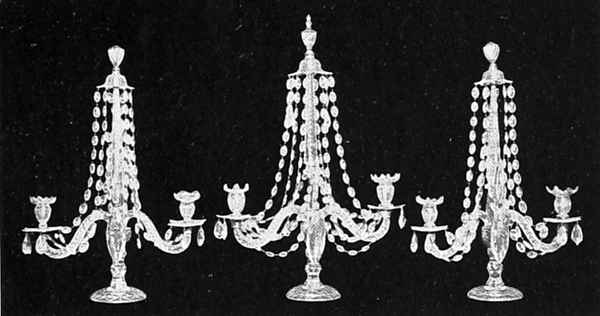
Three Waterford Table Lights, Adam period, 24 in. high, with "almond" drops.
In Major Pope's collection.

Waterford Chandelier, 4 ft. 3 in. long. Circa 1783.
In Mrs. Cox's collection.
Early Waterford Candelabra and pair of Candlesticks
with facet-cut ornament.
In Colonel Jenner's collection.

Adam Chandelier, Waterford, in its original condition. 5 ft. long.
In Mrs. Sabin's collection.
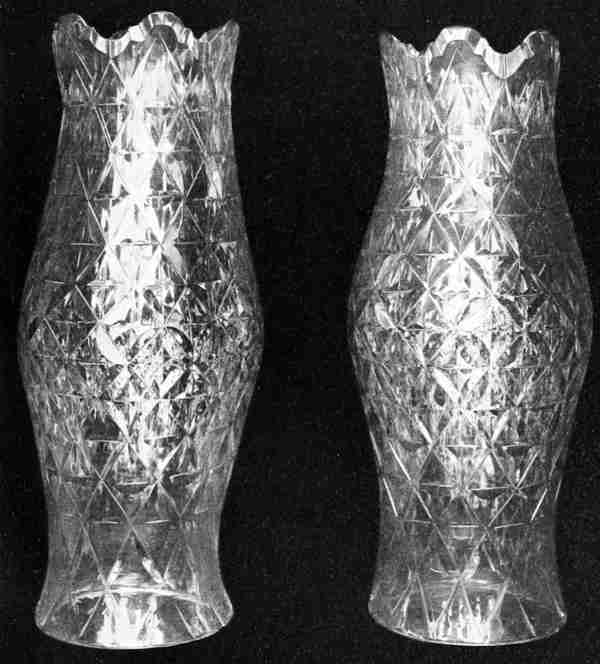
Irish Candle Shades, 23 in. high; finest period. One cut flat double stars. These shades were used in halls and covered large-size church candles. Unique specimens.
In the Author's collection.
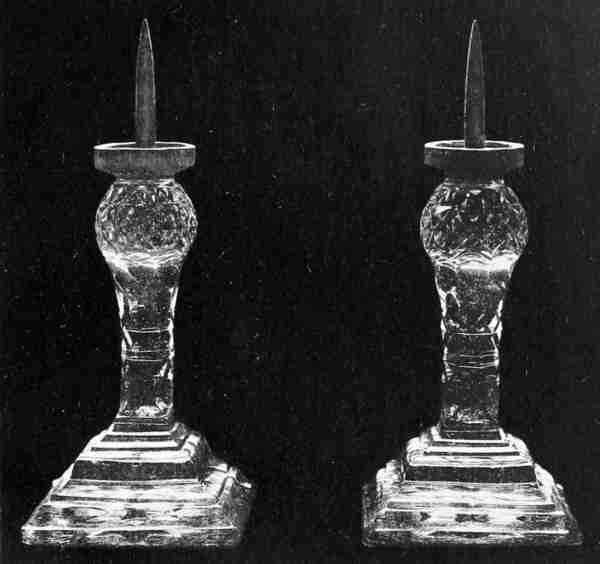
Pair of Waterford Alter Candlesticks. Circa 1783.
In Mr. R. Frank's collection.
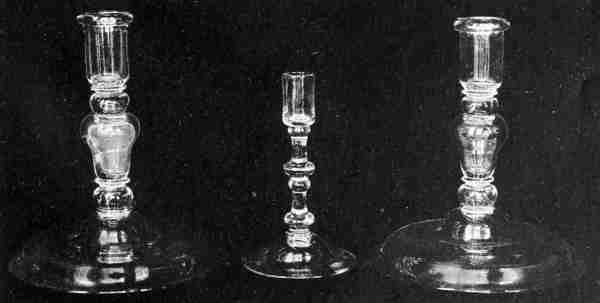
Three unique early Irish Candlesticks. Probably 1760.
In Mrs. Rea's collection.
These candlesticks have the largest bases on record, with high domes, and bear the "pontil" mark on top of the nozzle instead of at the bottom. They were made upside down.
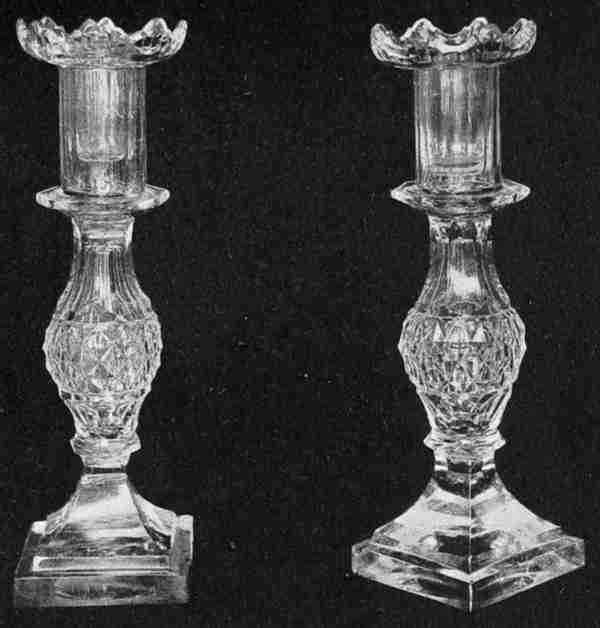
Very large Irish Candlesticks, with unusual bases. Circa 1770.
In Mrs. Rea's collection.
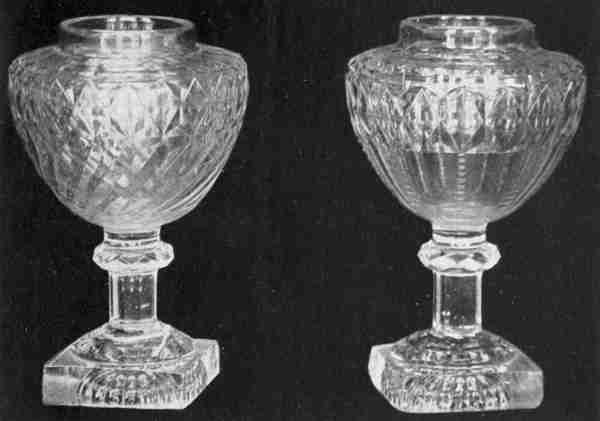
Pair of Irish Lamps. Probably Waterford, 1790. Very unusual specimens.
In the Walter Harding collection.
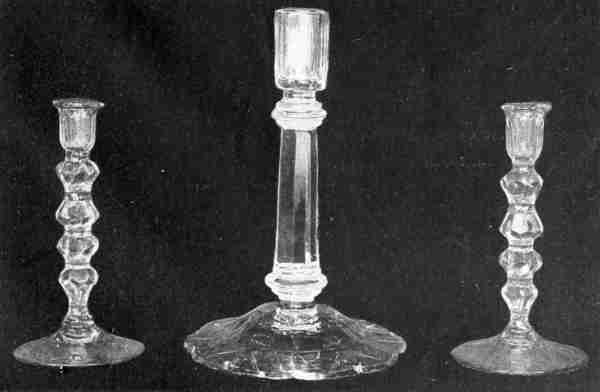
Waterford Candlestick, 1783, 14 in. high; and a pair of early Cork Candlesticks, 12 in. high.
In the Walter Harding collection.
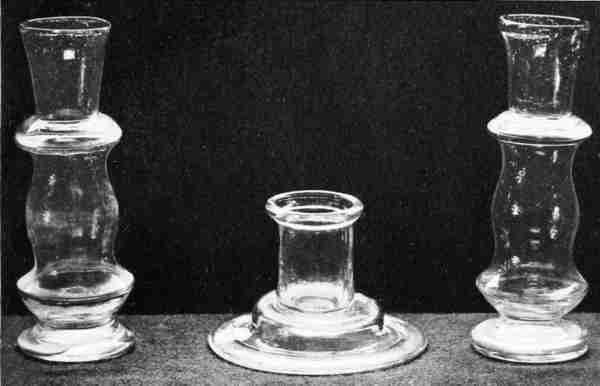
Set of three very early Irish Blown Glass Rushlight Holders, early eighteenth century.
In Mr. Robert Frank's collection.

Pair of antique Altar Candlesticks, about 16 in. high. Waterford, of the very finest period and cutting.
In the Walter Harding collection.
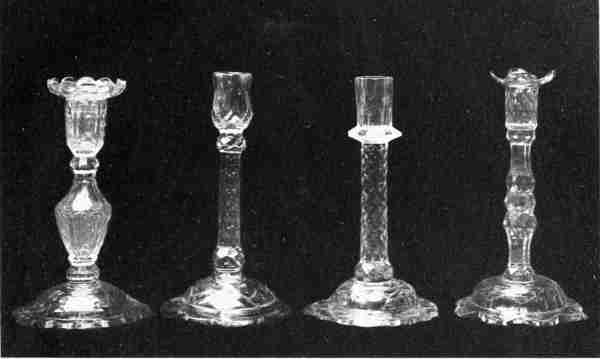
Four fine specimens of Waterford Candlesticks.
In the Walter Harding collection.

A wonderful Irish deep-coloured, moulded Mug, 8 in. high. Probably Dublin. Circa 1740.
In the Walter Harding collection.
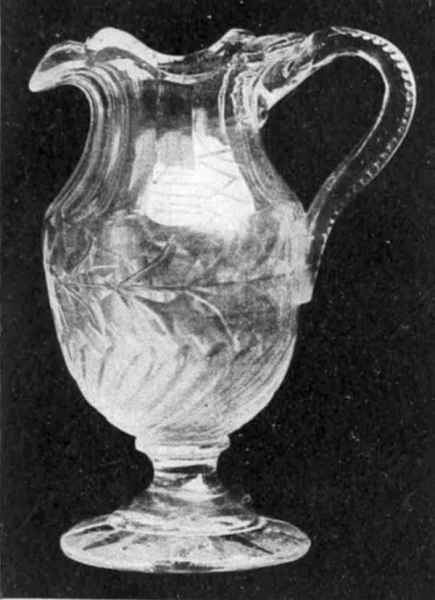
Shaped Waterford Jug. 11 in. high.
In the Walter Harding collection.

Unique Jug, ordinarily termed a "freak piece." 25 in. high, weighing 18 lbs. Irish glass, circa 1760. An ordinary cream jug is placed beside it for purposes of comparison.
In the Author's collection.
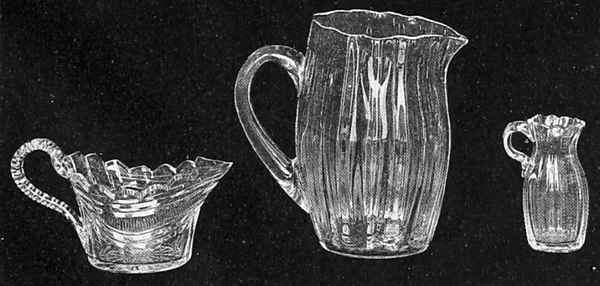
Three very interesting Irish Jugs. The two cream jugs are finest period Waterford. The centre jug is very early and the metal peculiarly soft.
In Mr. R. Philipson's collection.

Tankard, Waterford or Cork, circa 1785. 9 in. high.
Two-handled Spun Cup, probably Dublin, 1750; deep
toned glass, very soft to the touch. 8 in. high.
In the Author's collection.
Heavy Lustre Cut Jug, flint glass, circa 1800. 7 in. high.
In Commander Swithinbank's collection.
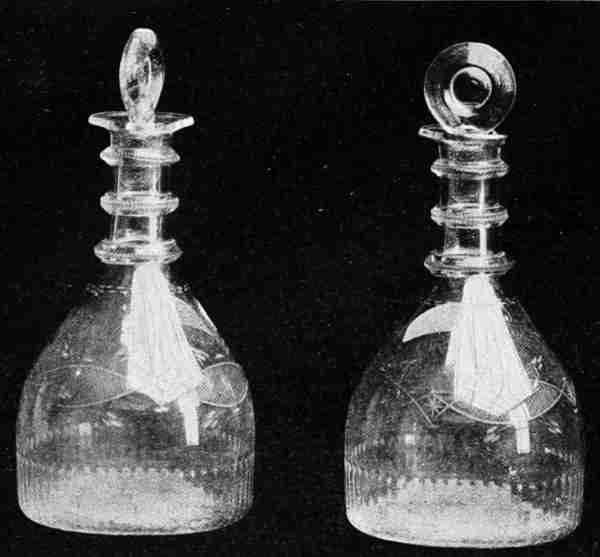
Early Blown Cork Decanters, with the primitive engraving of the period. These decanters are impress-marked "Cork Glass Co."
In the Author's collection.

Pair of heavy old Munster Glass Liqueur Bottles and an early Blown Irish Glass Decanter, engraved.
In the Author's collection.
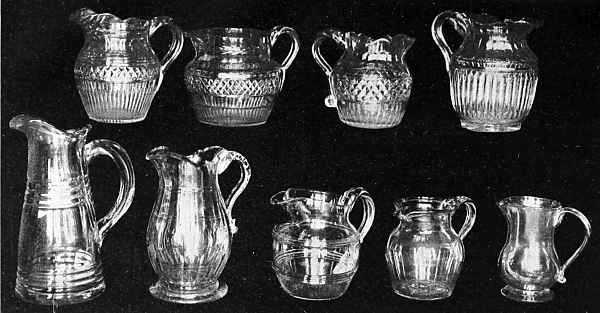
Set of early "Munster" Jugs.
In the Author's collection.
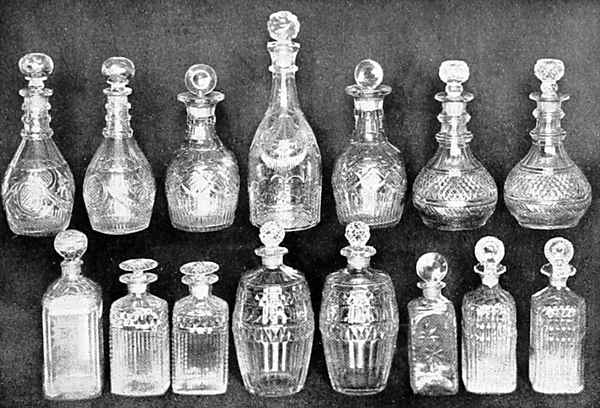
Set of early "Munster" Decanters.
In the Author's collection.

Set of early "Munster" Decanters.
In the Author's collection.
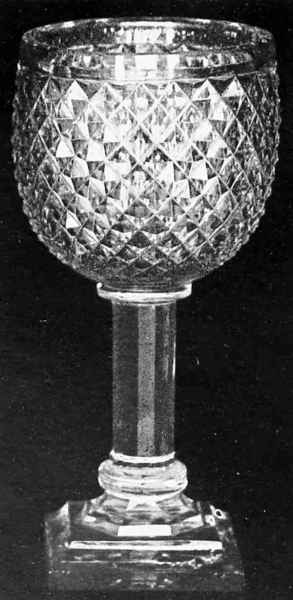
Chalice, 1790-1800. Sharp diamond cut, 13 in. high. One of the rarest pieces of Irish glass.
In Mrs. Hall's collection.
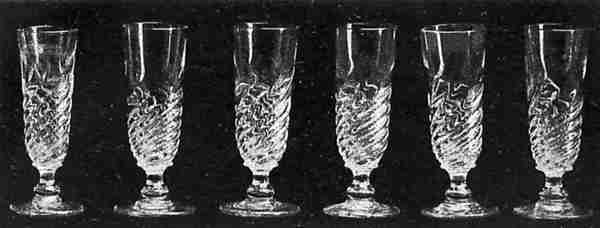
A set of Dublin "lustre Cut" Goblets, circa 1850.
The property of Mr. David Blair, who has a similar set of tumblers.
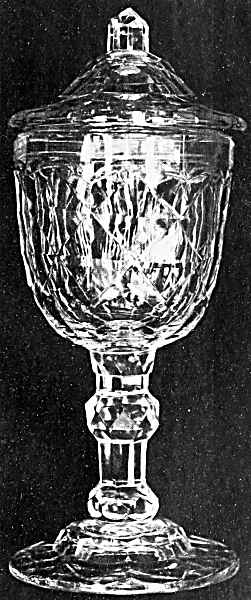
A rare Chalice. Munster glass, 1790-1800.
In Mrs. Magee's collection.

A Waterford Basket Sweetmeat Stand, 24 in. high.
In Mrs. Magee's collection.
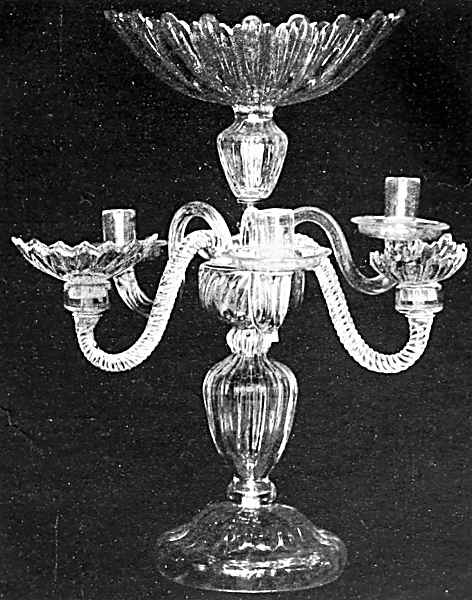
Moulded Sweetmeat Stand, with two candle sconces. Early Cork.
In Mrs. Magee's collection.
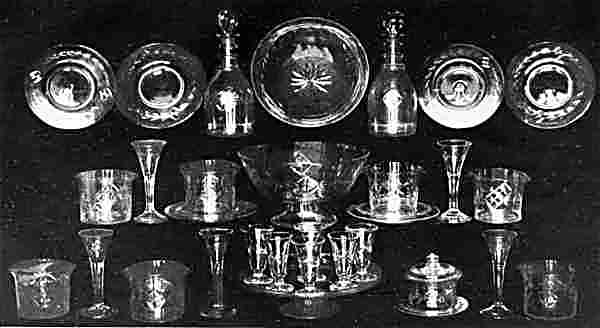
An entire early Waterford Dessert Service. Leaf cutting, and "drawn stem" wine-glasses.
In the possession of the Hon. Mrs. Vickers.

Waterford Dessert Service, circa 1785.
In the collection of Major Pope.

A miniature Waterford Sweetmeat Stand, only 13 in. high. The handles of the baskets are glass, and the piece is a most beautiful colour. Late Adam period.
In the Walter Harding collection.
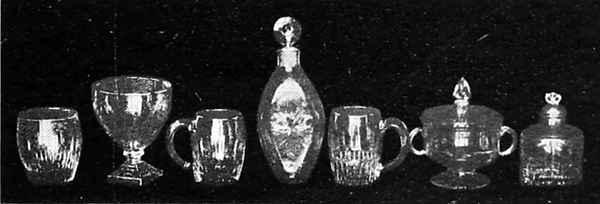
Early Dublin Posset Two-handled Bowl, 1760; Flat Flask, 1770; Goblets, Mugs, and Tea Caddy of early dates.
In the Author's collection.

Table Service of Engraved Cork Glass, early Adam period. Glass older than the engraving.
In the collection of Mr. Robert Frank.
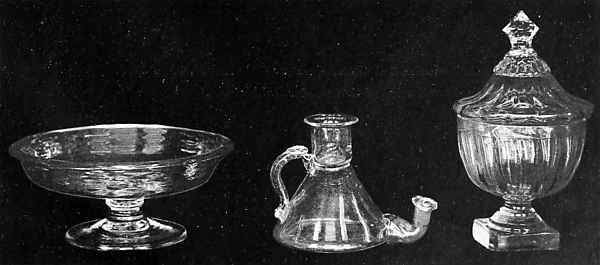
Early Irish Glass, the lamp probably as early as 1660.
Originally in the Author's collection; now in the Walter Harding collection.
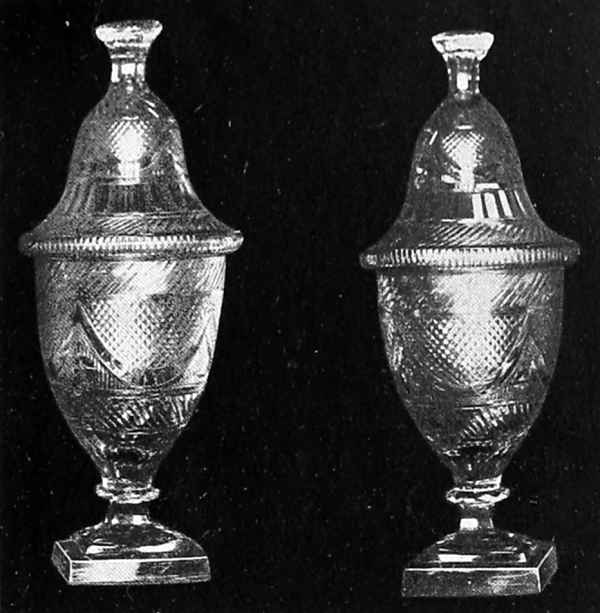
Pair of early Irish Urns, 22 in. high. Magnificent soft dark metal and very shallow cutting. Probably no duplicates.
In the collection of Commander Swithinbank.
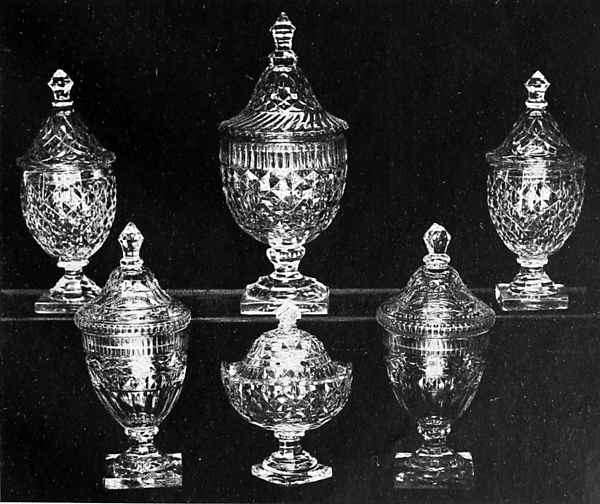
Collection of tall Urns, Cork and Waterford, circa 1785.
In the collection of Commander Swithinbank.
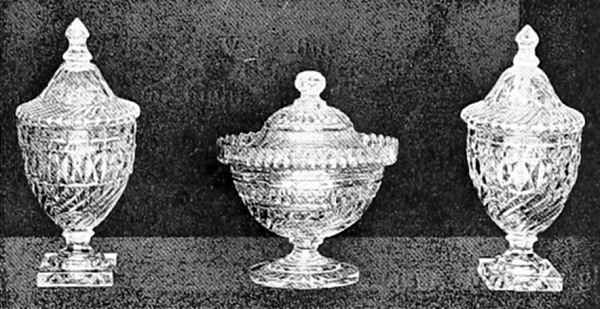
Set of three Waterford Urns, circa 1783. Very fine examples of flat cutting. 14 in. and 12 in. high.
In the collection of Mrs. Hall.
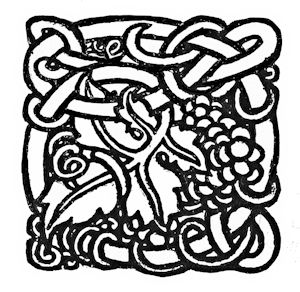
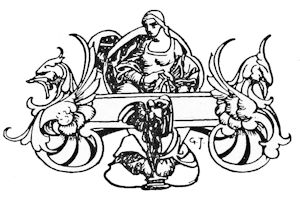
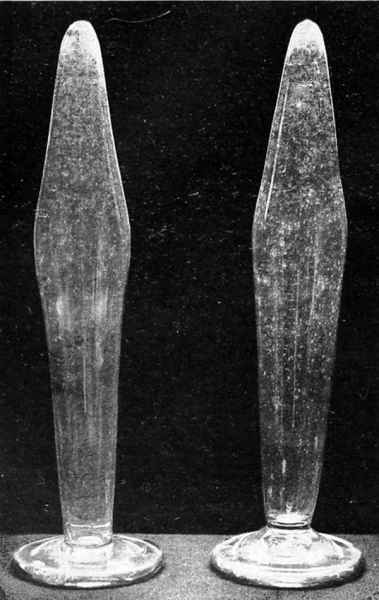
Pair of Wig Stands, probably Dublin, heavy lead-coloured glass of an early period.
In Mr. Robert Frank's collection.

Old Strawberry Cut Dublin Teapot.
In Mrs. Day's collection.
Old Munster Glass Teapot, moulded.
In the Author's collection.
Teapot. Waterford, circa 1783.
In Mr. Robert Frank's collection.
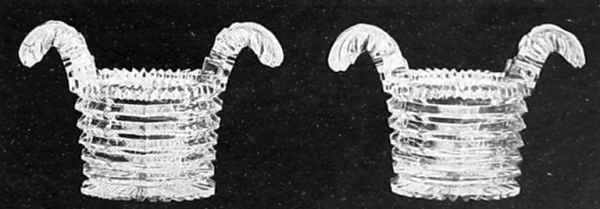
Cream Or Ice Pails, Irish, circa 1825-35. A wonderful example of deep step cutting, with feather handles. The glass is nearly ¾ in. thick.
In the possession of Mrs. McBean.
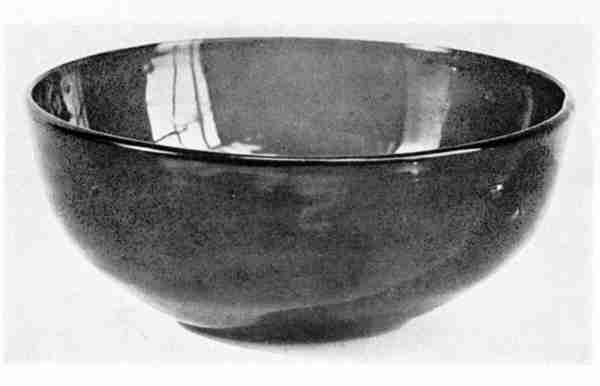
A very fine old Irish blue glass Bowl, with a magnificent ring, 9 in. diam.
In the Author's family collection.

A very rare Dublin blue glass Bowl, with unfinished foot, 8 in. high; extremely heavy. Specially made, circa 1740.
In the Author's family collection.

Pair of Lacemaker's Lamps, heavy purple-blue glass, made in Dublin, circa 1730-40. 13 in. high.
In the Author's family collection.
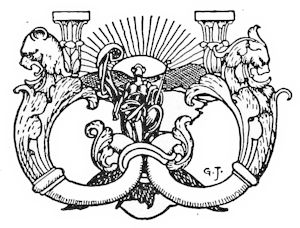

The only cutting on a rare canoe-shaped Waterford bowl in the Author's collection. "Flutes" also a very early idea, but became deeper and smaller and sharper as time went on.
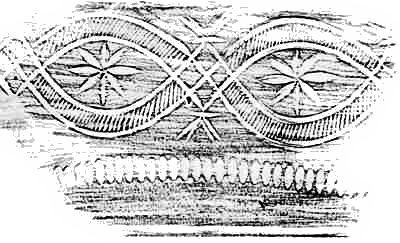
A wonderful special cutting on a "pinched" Waterford boat-shaped bowl a little deeper than engraving.
In the Author's collection.
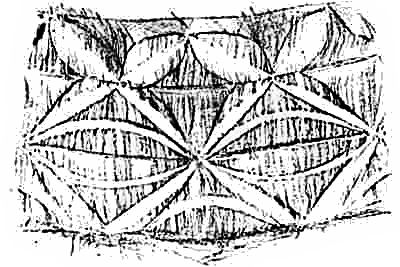
Vandyke cutting, more commonly known as "bull's-eye." A cutting very much done between 1770 and 1800, and probably more copied both abroad and in England than any other. Sometimes referred to as "Geometrical design."
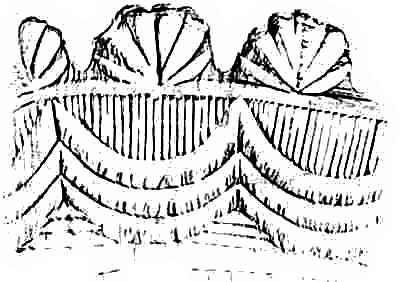
Beautiful swag and line cutting with fan edge. This is an early effort, probably 1765; but there is a fine example on a Waterford dessert service in the possession of Colonel Wike.
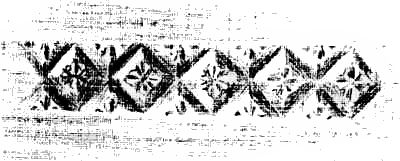
Hobnail cutting, late 1830, so often confused with diamond cutting.

Strawberry cutting, so often confused with hobnail cutting; much used from 1780. This is an early example. Note the unevenness of the lines.
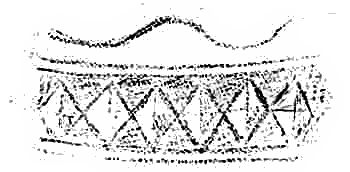
Flat diamond. This was a shallow cutting from circa 1768 onwards; after 1790 it became much deeper and sharper, the centre coming out to a sharp point.
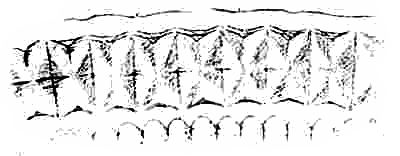
"Double," or "long" diamond, so often called in England "lozenge." It was a very soft shallow cutting till after 1780, when it became bolder and deeper.
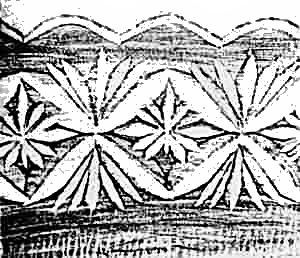
One of many adaptations of cutting on Irish glass from 1790 to 1835.
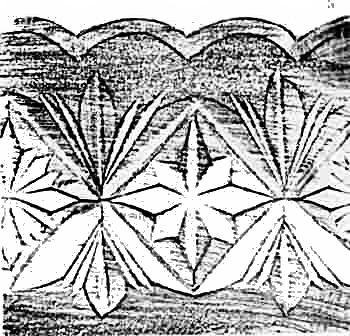
One of many adaptations of cutting on Irish glass from 1790 to 1835.
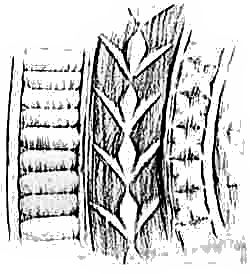
Cutting from a rare Waterford bowl. "Leaf," "shallow diamond," and "flute." This early cutting was very irregular, and so shallow that it is little deeper than heavy engraving.
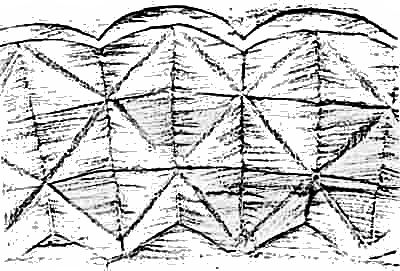
A most rare and very shallow adaptation of diamond cutting from an old Irish chalice, circa 1770.
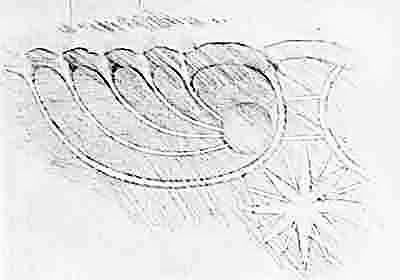
A most beautiful bit of cutting on a rare early Waterford mirror in Commander Swithinbank's collection.
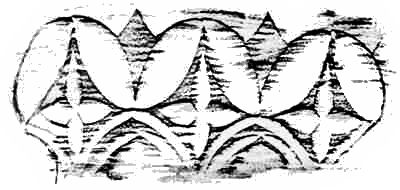
Curious shallow cutting from a set of Cork plates and finger-bowls in the Author's collection.
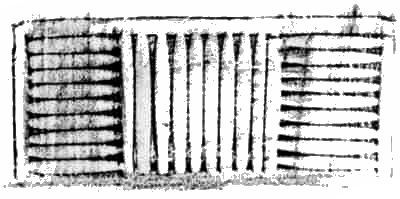
An example of step cutting, horizontal and vertical, from a late Waterford bowl.

Cutting from an early Waterford canoe-shaped bowl.
In the Author's collection.

Very early cutting from Mr. Weguelin's Waterford urns, showing the remarkable inaccuracy of the cutting.
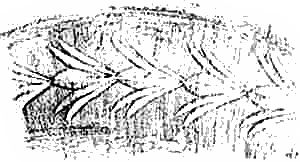
A variation of the early leaf cutting, somewhat later, therefore a little sharper and more symmetrical.
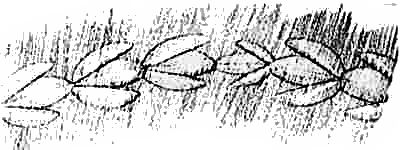
Flat "leaf," one of the first ideas of cutting. It is so soft that to the touch it is almost like moulding.

A wonderful example of "lustre" cutting. Dublin, circa 1785.
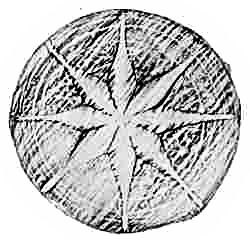
A soft early star found on the bottoms of finger-bowls and decanters, circa 1750. Note the remarkable variation from the given centre.
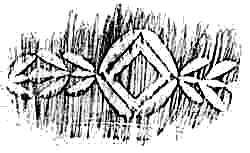
A very early husk or leaf cutting from an early Irish wine-glass, circa 1760. This is one of the earliest cuttings.

Plate XI caption, removed "." from "rainbow." band.
HTML version, illustrations have been laid out sequentially, with captions below each.
End of the Project Gutenberg EBook of Old Irish Glass, by Graydon Stannus
*** END OF THIS PROJECT GUTENBERG EBOOK OLD IRISH GLASS ***
***** This file should be named 45570-h.htm or 45570-h.zip *****
This and all associated files of various formats will be found in:
http://www.gutenberg.org/4/5/5/7/45570/
Produced by Chris Curnow, Chris Jordan and the Online
Distributed Proofreading Team at http://www.pgdp.net (This
file was produced from images generously made available
by The Internet Archive)
Updated editions will replace the previous one--the old editions
will be renamed.
Creating the works from public domain print editions means that no
one owns a United States copyright in these works, so the Foundation
(and you!) can copy and distribute it in the United States without
permission and without paying copyright royalties. Special rules,
set forth in the General Terms of Use part of this license, apply to
copying and distributing Project Gutenberg-tm electronic works to
protect the PROJECT GUTENBERG-tm concept and trademark. Project
Gutenberg is a registered trademark, and may not be used if you
charge for the eBooks, unless you receive specific permission. If you
do not charge anything for copies of this eBook, complying with the
rules is very easy. You may use this eBook for nearly any purpose
such as creation of derivative works, reports, performances and
research. They may be modified and printed and given away--you may do
practically ANYTHING with public domain eBooks. Redistribution is
subject to the trademark license, especially commercial
redistribution.
*** START: FULL LICENSE ***
THE FULL PROJECT GUTENBERG LICENSE
PLEASE READ THIS BEFORE YOU DISTRIBUTE OR USE THIS WORK
To protect the Project Gutenberg-tm mission of promoting the free
distribution of electronic works, by using or distributing this work
(or any other work associated in any way with the phrase "Project
Gutenberg"), you agree to comply with all the terms of the Full Project
Gutenberg-tm License available with this file or online at
www.gutenberg.org/license.
Section 1. General Terms of Use and Redistributing Project Gutenberg-tm
electronic works
1.A. By reading or using any part of this Project Gutenberg-tm
electronic work, you indicate that you have read, understand, agree to
and accept all the terms of this license and intellectual property
(trademark/copyright) agreement. If you do not agree to abide by all
the terms of this agreement, you must cease using and return or destroy
all copies of Project Gutenberg-tm electronic works in your possession.
If you paid a fee for obtaining a copy of or access to a Project
Gutenberg-tm electronic work and you do not agree to be bound by the
terms of this agreement, you may obtain a refund from the person or
entity to whom you paid the fee as set forth in paragraph 1.E.8.
1.B. "Project Gutenberg" is a registered trademark. It may only be
used on or associated in any way with an electronic work by people who
agree to be bound by the terms of this agreement. There are a few
things that you can do with most Project Gutenberg-tm electronic works
even without complying with the full terms of this agreement. See
paragraph 1.C below. There are a lot of things you can do with Project
Gutenberg-tm electronic works if you follow the terms of this agreement
and help preserve free future access to Project Gutenberg-tm electronic
works. See paragraph 1.E below.
1.C. The Project Gutenberg Literary Archive Foundation ("the Foundation"
or PGLAF), owns a compilation copyright in the collection of Project
Gutenberg-tm electronic works. Nearly all the individual works in the
collection are in the public domain in the United States. If an
individual work is in the public domain in the United States and you are
located in the United States, we do not claim a right to prevent you from
copying, distributing, performing, displaying or creating derivative
works based on the work as long as all references to Project Gutenberg
are removed. Of course, we hope that you will support the Project
Gutenberg-tm mission of promoting free access to electronic works by
freely sharing Project Gutenberg-tm works in compliance with the terms of
this agreement for keeping the Project Gutenberg-tm name associated with
the work. You can easily comply with the terms of this agreement by
keeping this work in the same format with its attached full Project
Gutenberg-tm License when you share it without charge with others.
1.D. The copyright laws of the place where you are located also govern
what you can do with this work. Copyright laws in most countries are in
a constant state of change. If you are outside the United States, check
the laws of your country in addition to the terms of this agreement
before downloading, copying, displaying, performing, distributing or
creating derivative works based on this work or any other Project
Gutenberg-tm work. The Foundation makes no representations concerning
the copyright status of any work in any country outside the United
States.
1.E. Unless you have removed all references to Project Gutenberg:
1.E.1. The following sentence, with active links to, or other immediate
access to, the full Project Gutenberg-tm License must appear prominently
whenever any copy of a Project Gutenberg-tm work (any work on which the
phrase "Project Gutenberg" appears, or with which the phrase "Project
Gutenberg" is associated) is accessed, displayed, performed, viewed,
copied or distributed:
This eBook is for the use of anyone anywhere at no cost and with
almost no restrictions whatsoever. You may copy it, give it away or
re-use it under the terms of the Project Gutenberg License included
with this eBook or online at www.gutenberg.org
1.E.2. If an individual Project Gutenberg-tm electronic work is derived
from the public domain (does not contain a notice indicating that it is
posted with permission of the copyright holder), the work can be copied
and distributed to anyone in the United States without paying any fees
or charges. If you are redistributing or providing access to a work
with the phrase "Project Gutenberg" associated with or appearing on the
work, you must comply either with the requirements of paragraphs 1.E.1
through 1.E.7 or obtain permission for the use of the work and the
Project Gutenberg-tm trademark as set forth in paragraphs 1.E.8 or
1.E.9.
1.E.3. If an individual Project Gutenberg-tm electronic work is posted
with the permission of the copyright holder, your use and distribution
must comply with both paragraphs 1.E.1 through 1.E.7 and any additional
terms imposed by the copyright holder. Additional terms will be linked
to the Project Gutenberg-tm License for all works posted with the
permission of the copyright holder found at the beginning of this work.
1.E.4. Do not unlink or detach or remove the full Project Gutenberg-tm
License terms from this work, or any files containing a part of this
work or any other work associated with Project Gutenberg-tm.
1.E.5. Do not copy, display, perform, distribute or redistribute this
electronic work, or any part of this electronic work, without
prominently displaying the sentence set forth in paragraph 1.E.1 with
active links or immediate access to the full terms of the Project
Gutenberg-tm License.
1.E.6. You may convert to and distribute this work in any binary,
compressed, marked up, nonproprietary or proprietary form, including any
word processing or hypertext form. However, if you provide access to or
distribute copies of a Project Gutenberg-tm work in a format other than
"Plain Vanilla ASCII" or other format used in the official version
posted on the official Project Gutenberg-tm web site (www.gutenberg.org),
you must, at no additional cost, fee or expense to the user, provide a
copy, a means of exporting a copy, or a means of obtaining a copy upon
request, of the work in its original "Plain Vanilla ASCII" or other
form. Any alternate format must include the full Project Gutenberg-tm
License as specified in paragraph 1.E.1.
1.E.7. Do not charge a fee for access to, viewing, displaying,
performing, copying or distributing any Project Gutenberg-tm works
unless you comply with paragraph 1.E.8 or 1.E.9.
1.E.8. You may charge a reasonable fee for copies of or providing
access to or distributing Project Gutenberg-tm electronic works provided
that
- You pay a royalty fee of 20% of the gross profits you derive from
the use of Project Gutenberg-tm works calculated using the method
you already use to calculate your applicable taxes. The fee is
owed to the owner of the Project Gutenberg-tm trademark, but he
has agreed to donate royalties under this paragraph to the
Project Gutenberg Literary Archive Foundation. Royalty payments
must be paid within 60 days following each date on which you
prepare (or are legally required to prepare) your periodic tax
returns. Royalty payments should be clearly marked as such and
sent to the Project Gutenberg Literary Archive Foundation at the
address specified in Section 4, "Information about donations to
the Project Gutenberg Literary Archive Foundation."
- You provide a full refund of any money paid by a user who notifies
you in writing (or by e-mail) within 30 days of receipt that s/he
does not agree to the terms of the full Project Gutenberg-tm
License. You must require such a user to return or
destroy all copies of the works possessed in a physical medium
and discontinue all use of and all access to other copies of
Project Gutenberg-tm works.
- You provide, in accordance with paragraph 1.F.3, a full refund of any
money paid for a work or a replacement copy, if a defect in the
electronic work is discovered and reported to you within 90 days
of receipt of the work.
- You comply with all other terms of this agreement for free
distribution of Project Gutenberg-tm works.
1.E.9. If you wish to charge a fee or distribute a Project Gutenberg-tm
electronic work or group of works on different terms than are set
forth in this agreement, you must obtain permission in writing from
both the Project Gutenberg Literary Archive Foundation and Michael
Hart, the owner of the Project Gutenberg-tm trademark. Contact the
Foundation as set forth in Section 3 below.
1.F.
1.F.1. Project Gutenberg volunteers and employees expend considerable
effort to identify, do copyright research on, transcribe and proofread
public domain works in creating the Project Gutenberg-tm
collection. Despite these efforts, Project Gutenberg-tm electronic
works, and the medium on which they may be stored, may contain
"Defects," such as, but not limited to, incomplete, inaccurate or
corrupt data, transcription errors, a copyright or other intellectual
property infringement, a defective or damaged disk or other medium, a
computer virus, or computer codes that damage or cannot be read by
your equipment.
1.F.2. LIMITED WARRANTY, DISCLAIMER OF DAMAGES - Except for the "Right
of Replacement or Refund" described in paragraph 1.F.3, the Project
Gutenberg Literary Archive Foundation, the owner of the Project
Gutenberg-tm trademark, and any other party distributing a Project
Gutenberg-tm electronic work under this agreement, disclaim all
liability to you for damages, costs and expenses, including legal
fees. YOU AGREE THAT YOU HAVE NO REMEDIES FOR NEGLIGENCE, STRICT
LIABILITY, BREACH OF WARRANTY OR BREACH OF CONTRACT EXCEPT THOSE
PROVIDED IN PARAGRAPH 1.F.3. YOU AGREE THAT THE FOUNDATION, THE
TRADEMARK OWNER, AND ANY DISTRIBUTOR UNDER THIS AGREEMENT WILL NOT BE
LIABLE TO YOU FOR ACTUAL, DIRECT, INDIRECT, CONSEQUENTIAL, PUNITIVE OR
INCIDENTAL DAMAGES EVEN IF YOU GIVE NOTICE OF THE POSSIBILITY OF SUCH
DAMAGE.
1.F.3. LIMITED RIGHT OF REPLACEMENT OR REFUND - If you discover a
defect in this electronic work within 90 days of receiving it, you can
receive a refund of the money (if any) you paid for it by sending a
written explanation to the person you received the work from. If you
received the work on a physical medium, you must return the medium with
your written explanation. The person or entity that provided you with
the defective work may elect to provide a replacement copy in lieu of a
refund. If you received the work electronically, the person or entity
providing it to you may choose to give you a second opportunity to
receive the work electronically in lieu of a refund. If the second copy
is also defective, you may demand a refund in writing without further
opportunities to fix the problem.
1.F.4. Except for the limited right of replacement or refund set forth
in paragraph 1.F.3, this work is provided to you 'AS-IS', WITH NO OTHER
WARRANTIES OF ANY KIND, EXPRESS OR IMPLIED, INCLUDING BUT NOT LIMITED TO
WARRANTIES OF MERCHANTABILITY OR FITNESS FOR ANY PURPOSE.
1.F.5. Some states do not allow disclaimers of certain implied
warranties or the exclusion or limitation of certain types of damages.
If any disclaimer or limitation set forth in this agreement violates the
law of the state applicable to this agreement, the agreement shall be
interpreted to make the maximum disclaimer or limitation permitted by
the applicable state law. The invalidity or unenforceability of any
provision of this agreement shall not void the remaining provisions.
1.F.6. INDEMNITY - You agree to indemnify and hold the Foundation, the
trademark owner, any agent or employee of the Foundation, anyone
providing copies of Project Gutenberg-tm electronic works in accordance
with this agreement, and any volunteers associated with the production,
promotion and distribution of Project Gutenberg-tm electronic works,
harmless from all liability, costs and expenses, including legal fees,
that arise directly or indirectly from any of the following which you do
or cause to occur: (a) distribution of this or any Project Gutenberg-tm
work, (b) alteration, modification, or additions or deletions to any
Project Gutenberg-tm work, and (c) any Defect you cause.
Section 2. Information about the Mission of Project Gutenberg-tm
Project Gutenberg-tm is synonymous with the free distribution of
electronic works in formats readable by the widest variety of computers
including obsolete, old, middle-aged and new computers. It exists
because of the efforts of hundreds of volunteers and donations from
people in all walks of life.
Volunteers and financial support to provide volunteers with the
assistance they need are critical to reaching Project Gutenberg-tm's
goals and ensuring that the Project Gutenberg-tm collection will
remain freely available for generations to come. In 2001, the Project
Gutenberg Literary Archive Foundation was created to provide a secure
and permanent future for Project Gutenberg-tm and future generations.
To learn more about the Project Gutenberg Literary Archive Foundation
and how your efforts and donations can help, see Sections 3 and 4
and the Foundation information page at www.gutenberg.org
Section 3. Information about the Project Gutenberg Literary Archive
Foundation
The Project Gutenberg Literary Archive Foundation is a non profit
501(c)(3) educational corporation organized under the laws of the
state of Mississippi and granted tax exempt status by the Internal
Revenue Service. The Foundation's EIN or federal tax identification
number is 64-6221541. Contributions to the Project Gutenberg
Literary Archive Foundation are tax deductible to the full extent
permitted by U.S. federal laws and your state's laws.
The Foundation's principal office is located at 4557 Melan Dr. S.
Fairbanks, AK, 99712., but its volunteers and employees are scattered
throughout numerous locations. Its business office is located at 809
North 1500 West, Salt Lake City, UT 84116, (801) 596-1887. Email
contact links and up to date contact information can be found at the
Foundation's web site and official page at www.gutenberg.org/contact
For additional contact information:
Dr. Gregory B. Newby
Chief Executive and Director
gbnewby@pglaf.org
Section 4. Information about Donations to the Project Gutenberg
Literary Archive Foundation
Project Gutenberg-tm depends upon and cannot survive without wide
spread public support and donations to carry out its mission of
increasing the number of public domain and licensed works that can be
freely distributed in machine readable form accessible by the widest
array of equipment including outdated equipment. Many small donations
($1 to $5,000) are particularly important to maintaining tax exempt
status with the IRS.
The Foundation is committed to complying with the laws regulating
charities and charitable donations in all 50 states of the United
States. Compliance requirements are not uniform and it takes a
considerable effort, much paperwork and many fees to meet and keep up
with these requirements. We do not solicit donations in locations
where we have not received written confirmation of compliance. To
SEND DONATIONS or determine the status of compliance for any
particular state visit www.gutenberg.org/donate
While we cannot and do not solicit contributions from states where we
have not met the solicitation requirements, we know of no prohibition
against accepting unsolicited donations from donors in such states who
approach us with offers to donate.
International donations are gratefully accepted, but we cannot make
any statements concerning tax treatment of donations received from
outside the United States. U.S. laws alone swamp our small staff.
Please check the Project Gutenberg Web pages for current donation
methods and addresses. Donations are accepted in a number of other
ways including checks, online payments and credit card donations.
To donate, please visit: www.gutenberg.org/donate
Section 5. General Information About Project Gutenberg-tm electronic
works.
Professor Michael S. Hart was the originator of the Project Gutenberg-tm
concept of a library of electronic works that could be freely shared
with anyone. For forty years, he produced and distributed Project
Gutenberg-tm eBooks with only a loose network of volunteer support.
Project Gutenberg-tm eBooks are often created from several printed
editions, all of which are confirmed as Public Domain in the U.S.
unless a copyright notice is included. Thus, we do not necessarily
keep eBooks in compliance with any particular paper edition.
Most people start at our Web site which has the main PG search facility:
www.gutenberg.org
This Web site includes information about Project Gutenberg-tm,
including how to make donations to the Project Gutenberg Literary
Archive Foundation, how to help produce our new eBooks, and how to
subscribe to our email newsletter to hear about new eBooks.